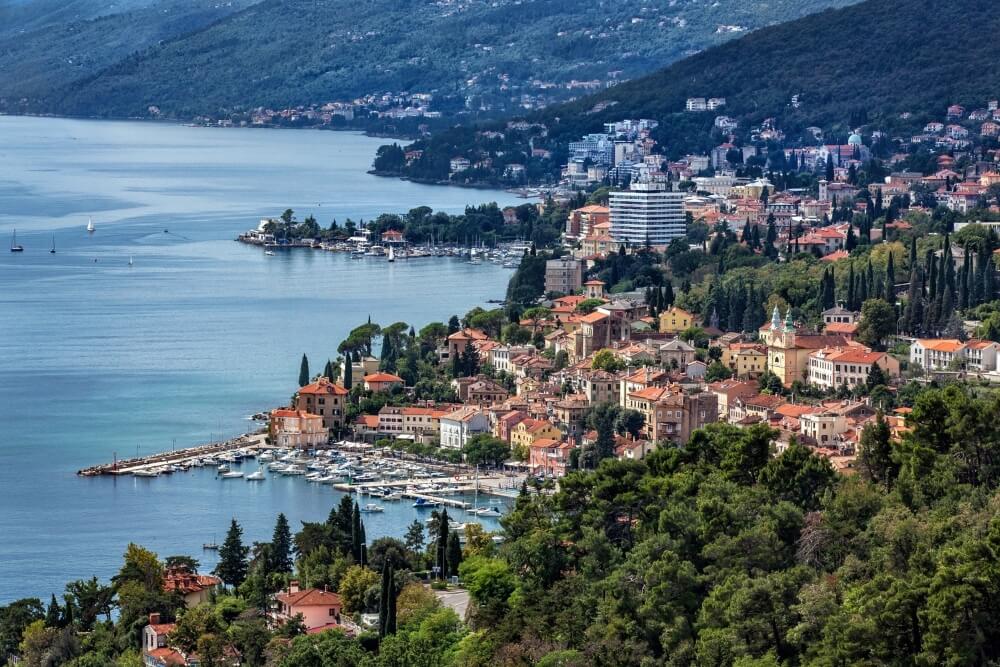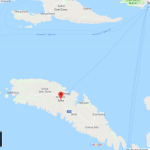An opulent stretch of Austro-Hungarian finery on the beautiful Kvarner coast. Opatija was Croatia’s first-ever tourist destination. As popular now as it always was, it’s easy to see why.
- Welcome to Opatija Croatia!
- Top 5 best things to do in Opatija
- Where to eat in Opatija? Opatija Restaurants
- 5 things you (maybe) didn’t know about the town
- Where to stay in Opatija? Opatija hotels, real estate, property
- Where is Opatija Croatia? Opatija map and location
- Weather Opatija Croatia
- Best day trips to make
- How to get to Opatija and get around
Welcome to Opatija Croatia!
A beautiful anomaly on the Adriatic shore, Opatija in Croatia sometimes looks more like Vienna than the Mediterranean. And, there’s a very good reason for this.
Over a century and a half ago, Opatija began hosting dignitaries of the Austro-Hungarian empire. They liked what they saw. Subsequently, the extended summers and mild year-round climate prompted some to build villas for themselves or hotels to house others. No expense was spared. All of a sudden, in place of the tiny traditional village that once was, lay a resplendent imperial city in miniature. Although, the royalty that walked its promenades and gardens were definitely the real deal.
Ever since then, the town has been popular with visitors. And it has earned a reputation for silver service in everything from its food and accommodation to its health, wellness and medical therapies.
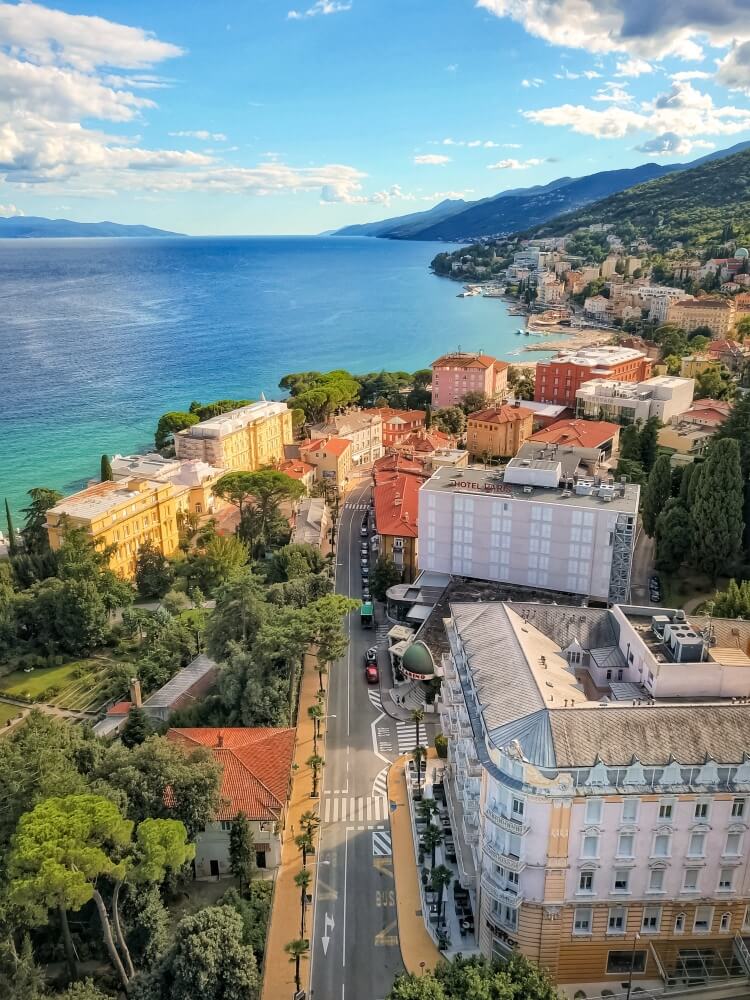
The Opatija Riviera is a 30 kilometre stretch of impeccable shoreline. Dotted with towns and villages, it is both a varied and exciting coast. Not only does it offer popular beaches and activities, but also secluded, hidden coves and incredible natural beauty. But, that’s too much to cover for now. Really, you’d need a book. Instead, we’ll here give you our best guide to Opatija itself. But, also including Volosko, its neighbour to the north. Together, they comprise one of the most exclusive destinations in Croatia. Their reputation for perfect holidays is as old as the beautiful town we today recognise as Opatija.
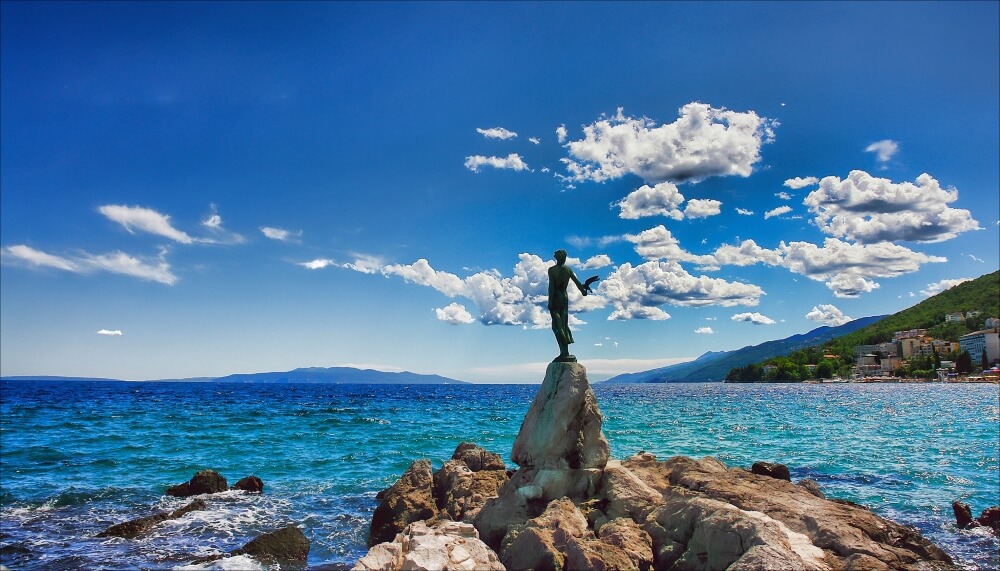
Top 5 best things to do in Opatija
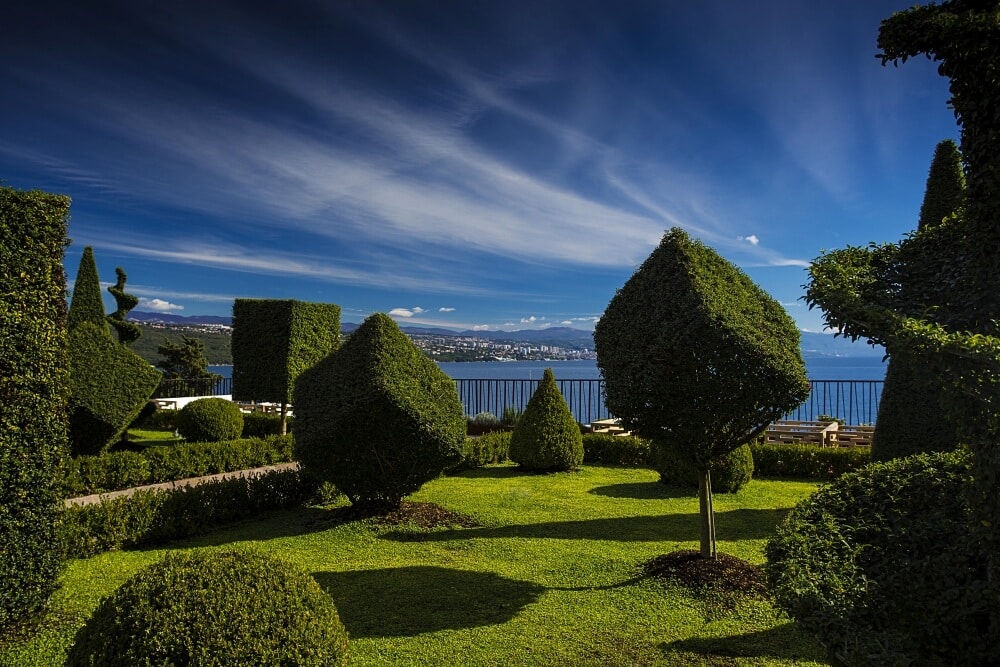
1) Opatija in pictures: Enjoy the beautiful parks and gardens of Opatija

Without reservation, it’s safe to say Opatija’s best attractions have stayed the same for almost 170 years. Of course, the beautiful bay and glistening sea were always here. But, the man-made adornments of the last century and a half now seem as timeless, complimenting accompaniments. No sooner had Opatija’s potential been recognised, than work was initiated on building the Lungomare promenade and the town parks.
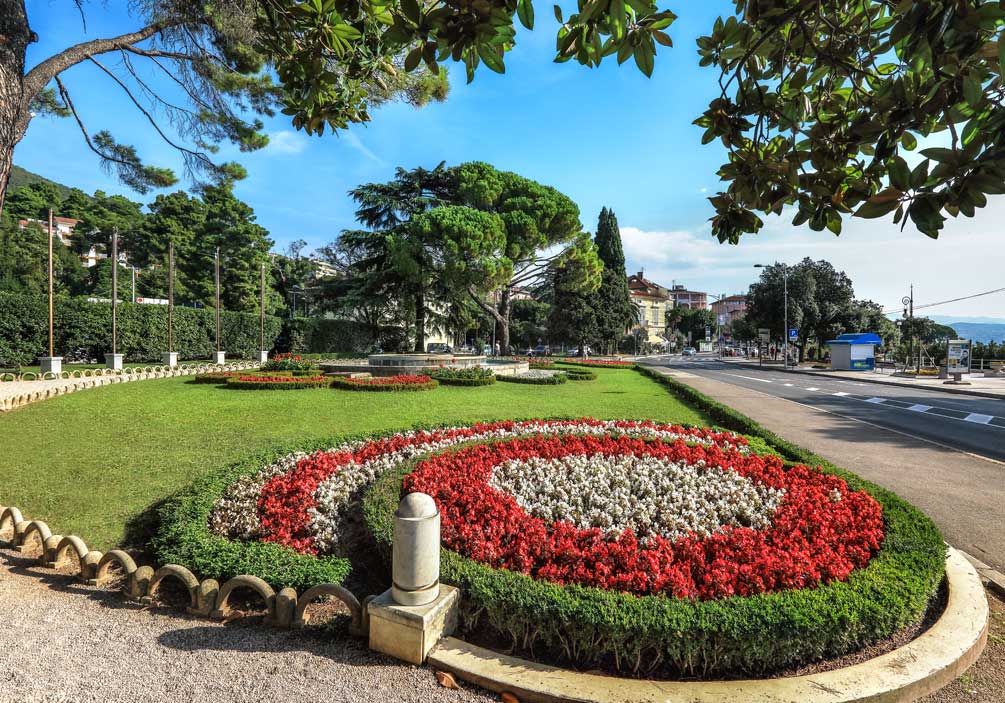
Carl Schubert, director of the Viennese Imperial-Royal Society for the construction of parks, was employed in their design. Glorious since completion, they are pristinely maintained. As a result, they are an unforgettable aspect of any visit to Opatija.
Angiolina Park
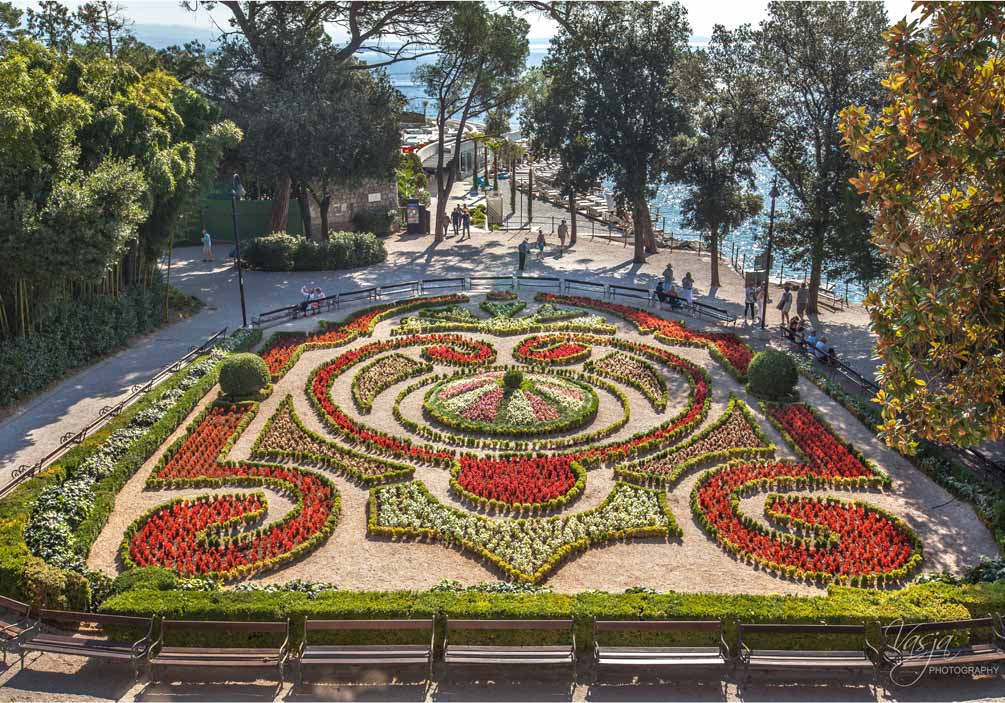
In more ways than one, Angiolina Park is in the very heart of Opatija. Iconic and unmissable, it is one of the most celebrated parks in Croatia. The camellia flowers that thrive here have been residents since the 19th century. Today, they are one of the emblems of the town. Additionally, you find a further 150 plant species here, some Mediterranean, others brought from all over the world.
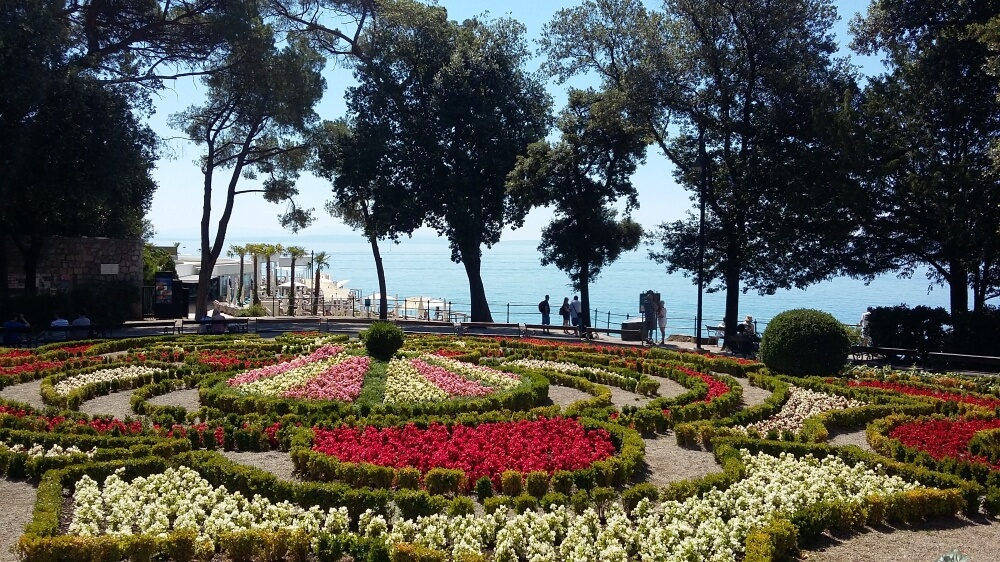
Walking through the park will lead you to Villa Angiolina. Also, a bandstand that has, in its time, entertained some very well-known names. Not only is the villa the first to have been built here, but it is also the birthplace of tourism in Croatia. But, more about that later in this page.
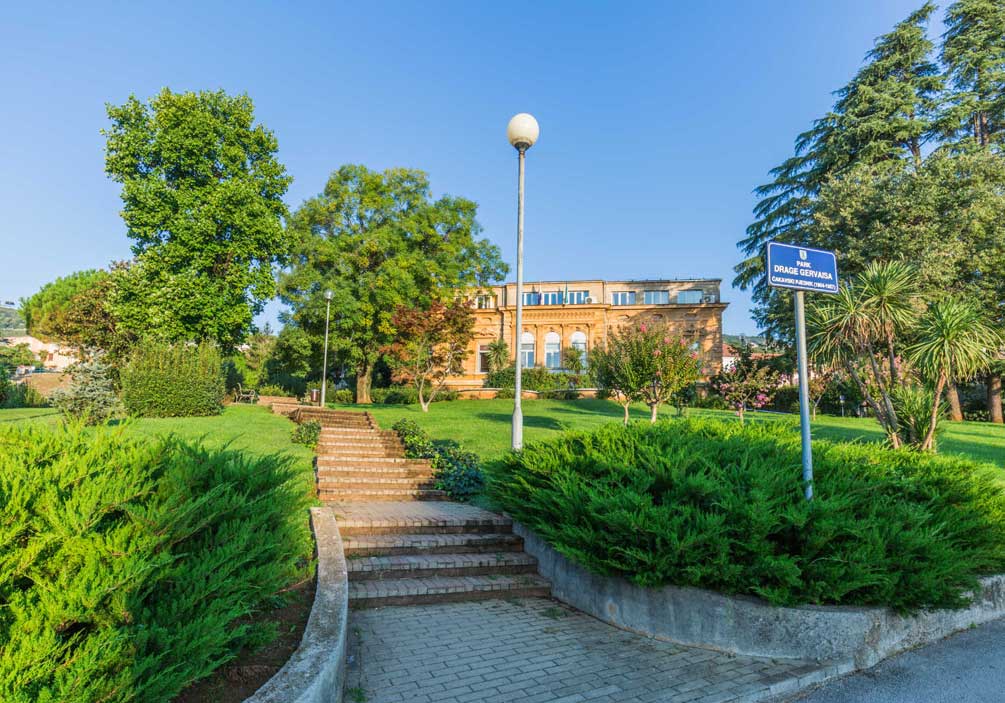
St. James’ Park
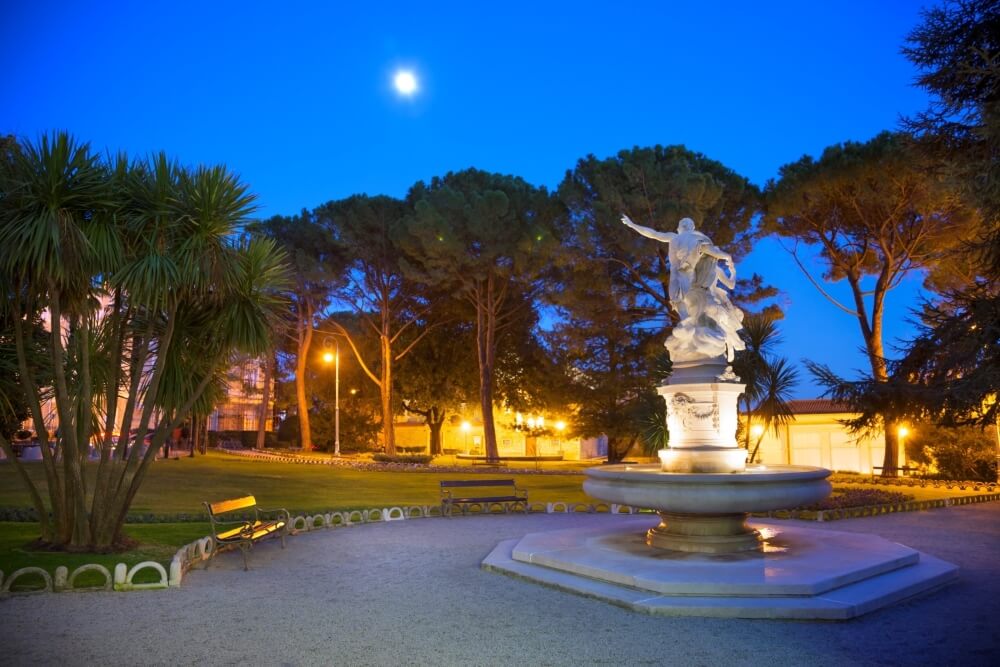
Sitting just 50 metres south of Angiolina, St. James’ Park is another celebration of dedicated cultivation. Its perfect green lawns provide a stunning contrast to the explosion of colour gifted by its flowers.
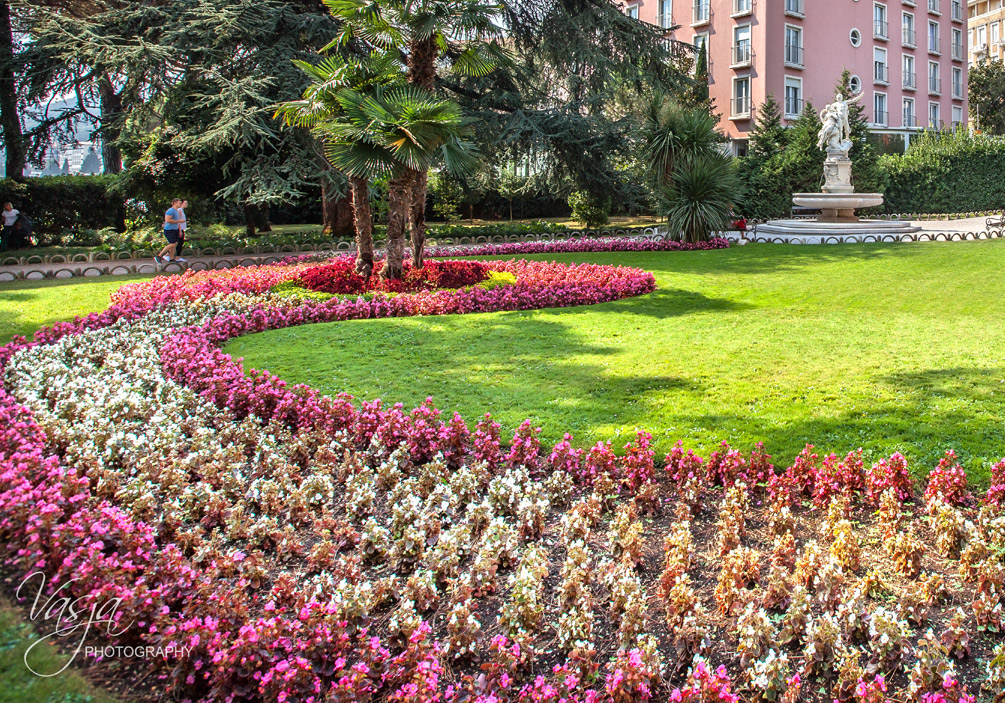
Atop its glorious neo-Baroque fountain, a sculpture by celebrated Austrian artist Johann Rathausky. Actually, he was a favourite sculptor of Emperor Franz Joseph. It depicts Helios and Selene, the Greek gods of the Sun and the Moon. Between them is a rooster, symbolizing the moment of their meeting – dawn.
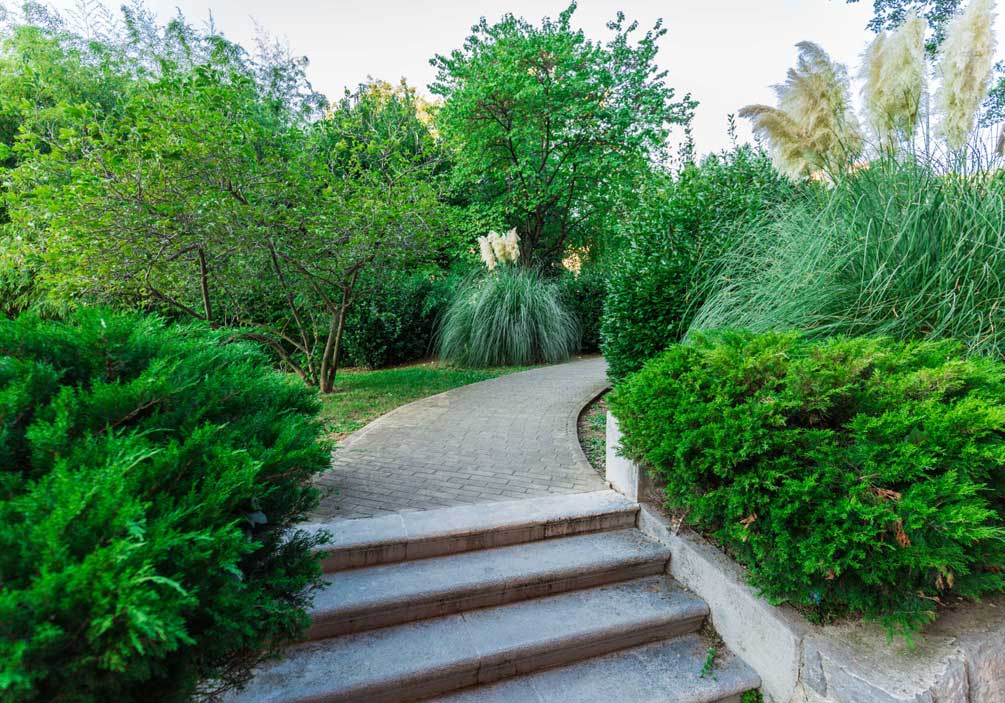
The American Gardens
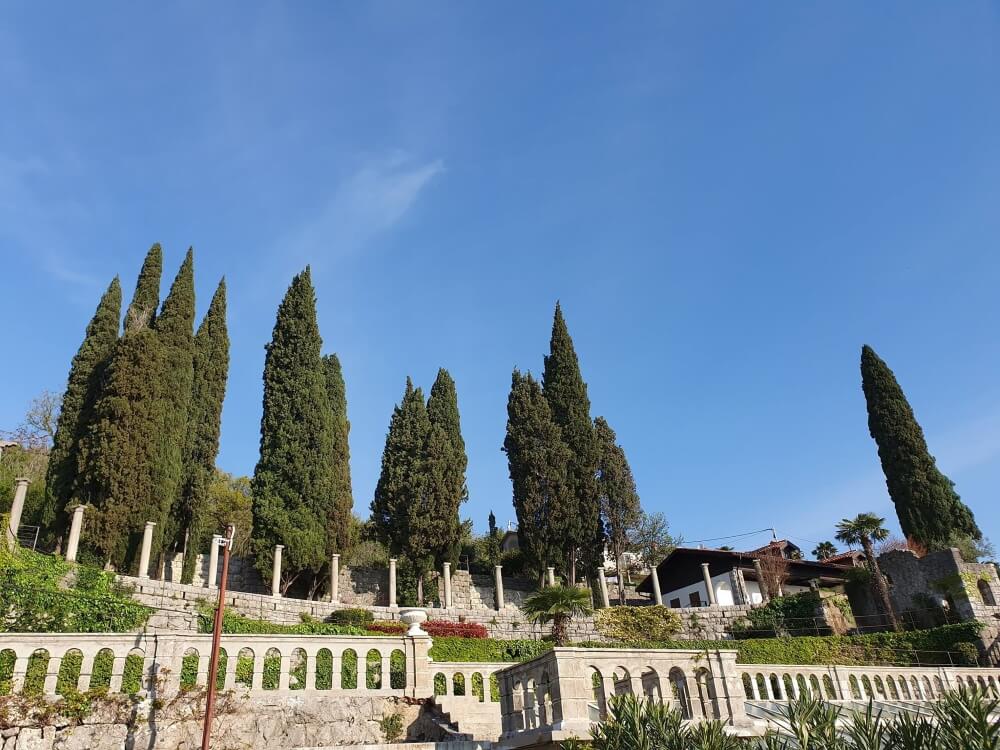
An incredible set of terraces, located on the opposite side of the Nova Cesta road to the shore. Actually, these gardens were built by a Hungarian, Mihály Pál Kuczor, in 1926. But, he had made his wealth exporting paprika to the States, explaining the garden’s name.
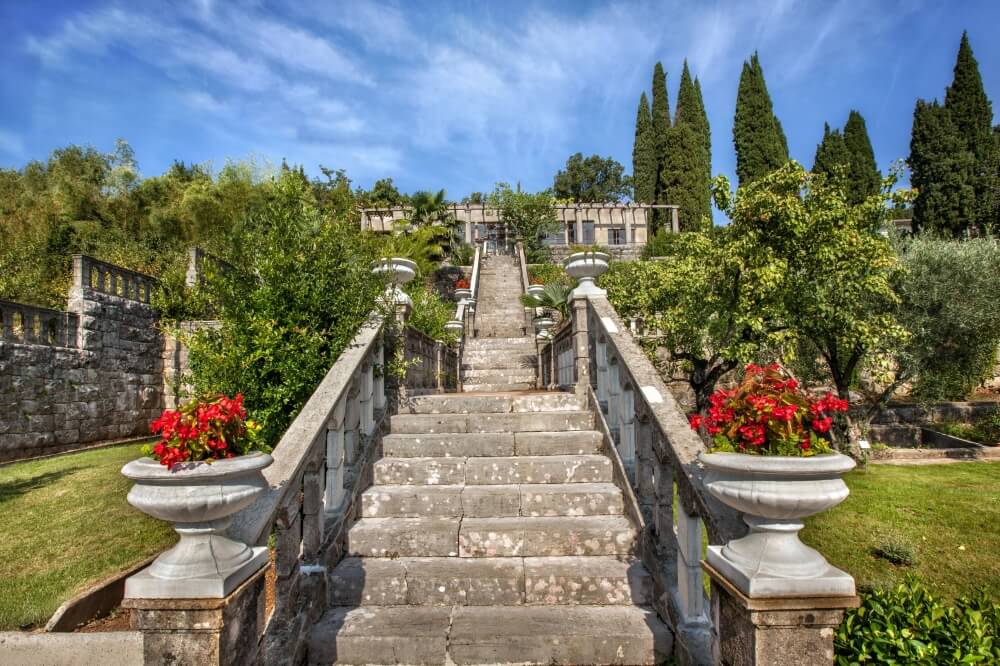
Originally, the gardens contained camphor, eucalyptus, camellias, gardenias, magnolias, Australian agaves, many roses and vitis vinifera. Of course, paprika too. Although the stonework here was fashioned to appear much older than it actually is, not all of the architecture here is folly. In fact, the gardens contain the ruins of the Šišina mirina building, named after original owner, Ivan Jurković Šiša. Indeed, the preservation of the building was a condition of the land sale to Kuczor.
Margarita Park
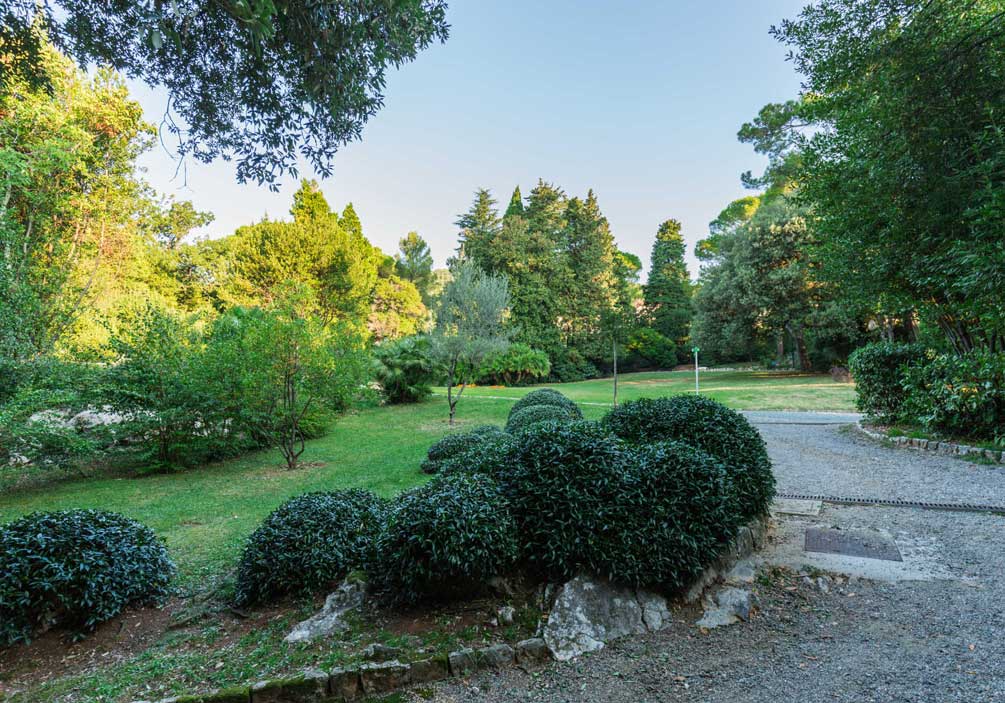
Away from the crowds, the secluded Margarita Park often offers peace and tranquility unavailable in its popular peers. Actually, it’s the second-largest and third oldest park in Opatija. It covers an area of 2.2 ha and was founded around 1900. The park is lined with a variety of trees, including California cedar, oak, a giant Sequoia and a Ginkgo biloba. These frame lawns decorated with arranged beds of flowers.
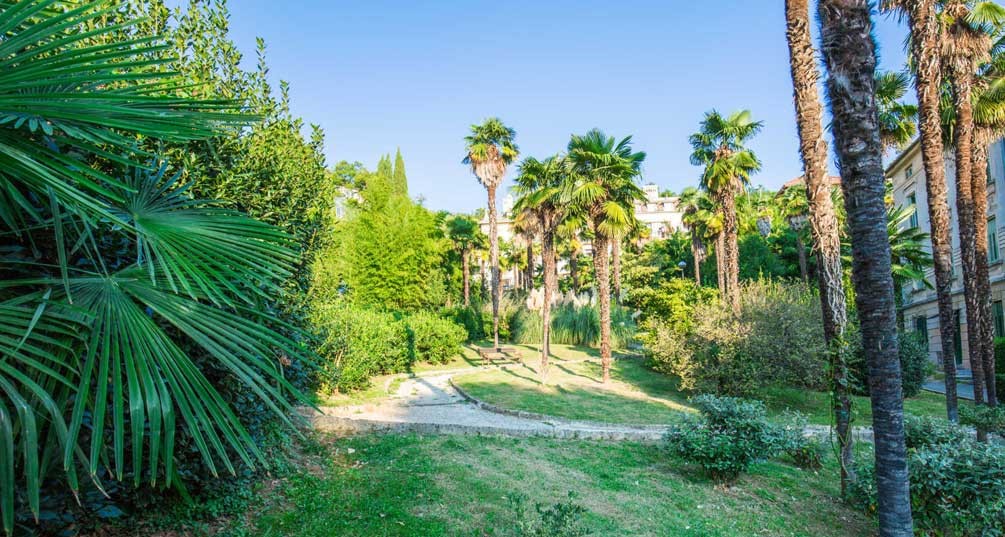
Christmas in Opatija
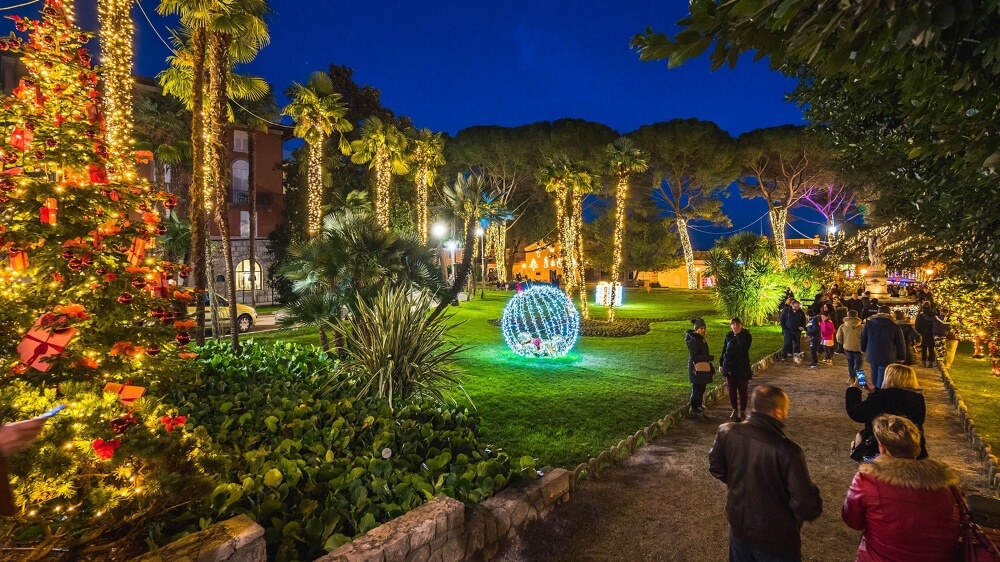
Undoubtedly, Opatija’s gardens are at their best when their flowers are in full bloom. Their colours come alive in the sheer light of the summer sun. However, this is not the only time the parks come to life.
Christmas in Opatija is a wonderful time to visit. Not least for the spectacular lights that are placed around the town. Moreover, the best displays are reserved for Opatija’s parks. Together with the magical lights in nearby Rijeka, they form a Kvarner Christmas that is one of the best Advent events in Croatia.
2) Lungomare and the forest path of Carmen Sylva (Šetalište Carmen Sylve)
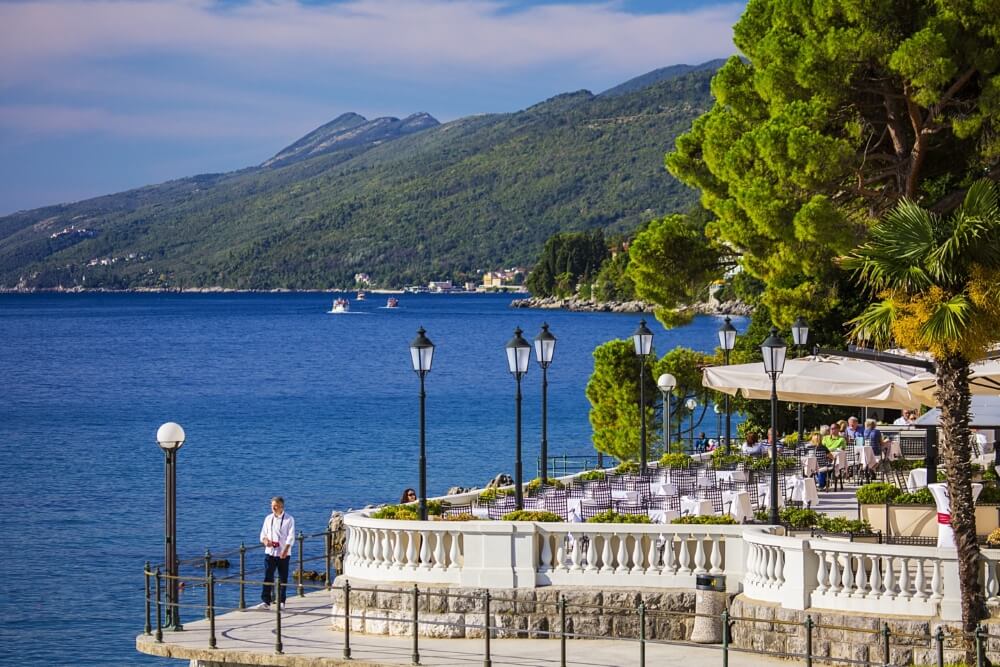
If your day is not complete without a pleasant walk, then this is the place for you. Because Opatija has two of the best.
Lungomare aka Franz Joseph I promenade
Without a doubt, Opatija’s Lungomare is one of the most enchanting seaside promenades on the whole Mediterranean. Officially titled Franz Joseph I promenade, it turns 130 years old in 2021. It stretches a huge 10 kilometres from Volosko in the north, via Opatija, to Lovran in the south.
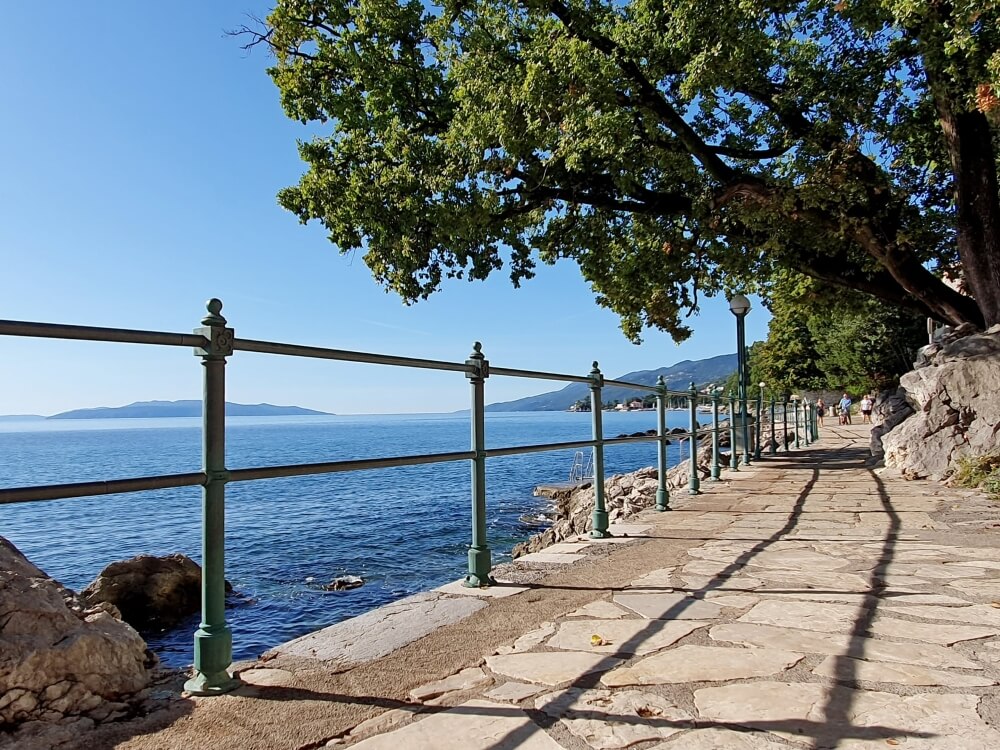
Passing beautiful parks, beaches and coves, you’ll meet a stunning array of architecture on the route. Also, famous landmarks like the statue of the Girl with the Seagull. She is one of the town symbols and stares out at Kvarner bay as if transfixed by its beauty. Surely, you’ll understand her reticence to turn from the gorgeous view when you see it for yourself. Timeless and unspoiled, Lungomare Opatija is the perfect promenade.
The forest path of Carmen Sylva (Šetalište Carmen Sylve)
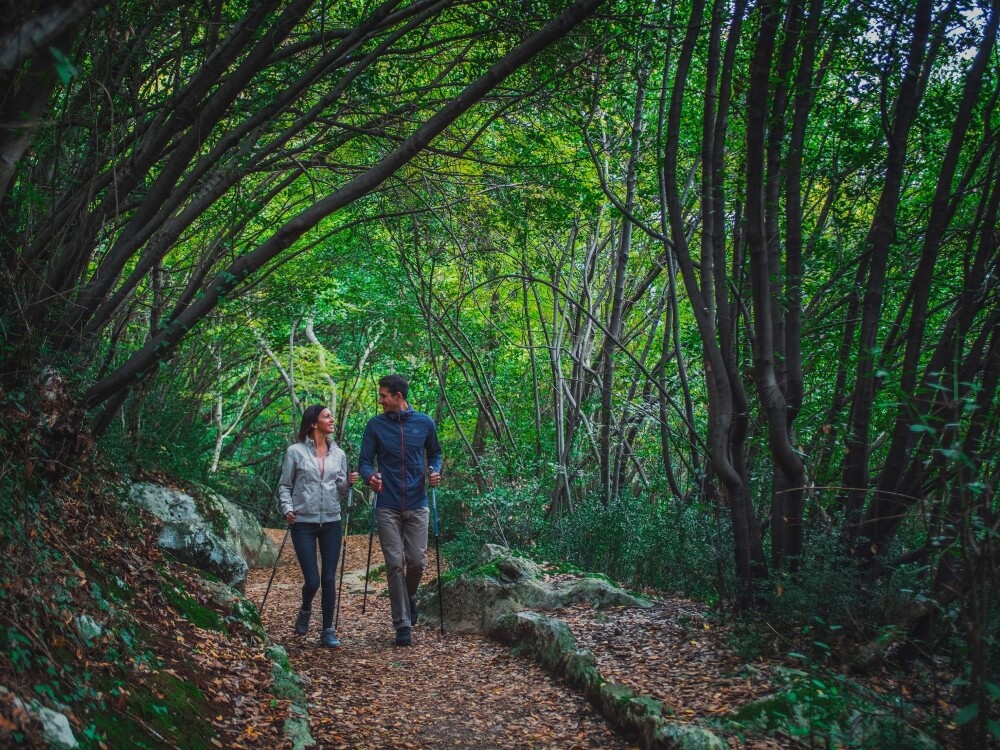
Along Lungomare you’ll pass under shading palms and alongside exquisite sculpted gardens and parks. But, if the truly untamed greenery of wild nature is more for you, then take a walk back from the shore. The Carmen Sylva promenade is 7 kilometres long and lined throughout with the inimitable scents of the forest.
Carmen Sylva
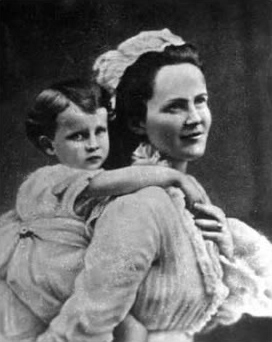
The path is named after Elisabeth of Wied (1843 – 1916). As the wife of King Carol I, she later became the Queen of Romania. Although, prior to this, she had already established herself as a writer, under the name Carmen Sylva. Markedly, she is remembered for her care of the sick. Firstly, as a regular visitor to sanitariums, later for tending to the war wounded.
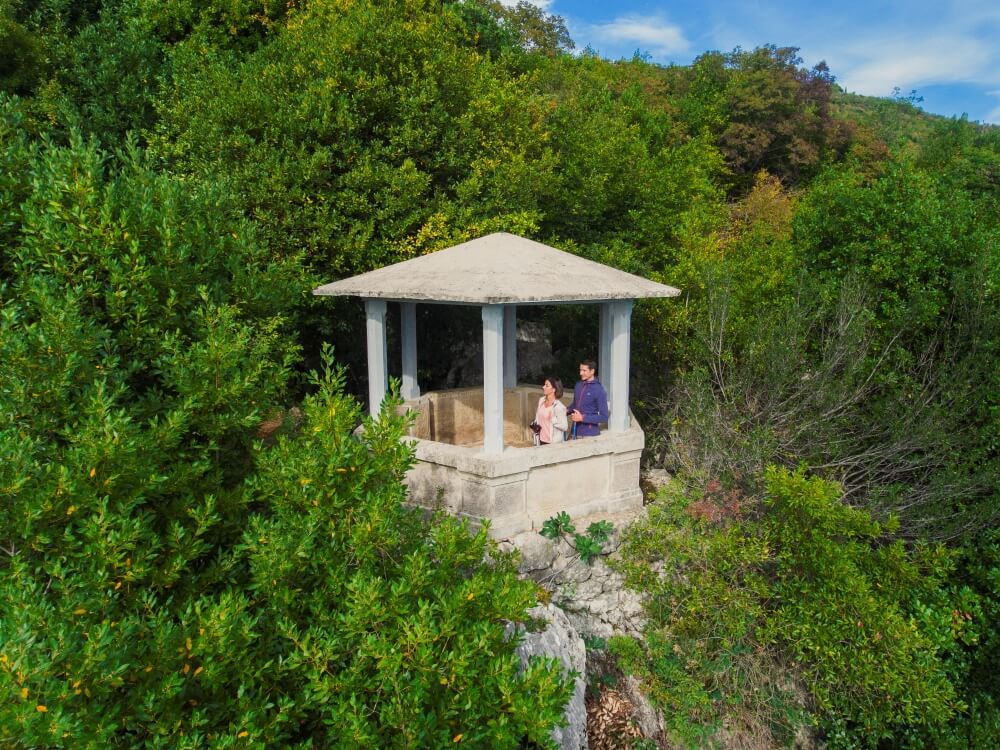
She applied her status well, founding Romania’s National Society for the Blind and becoming the first royal patron of the Romanian Red Cross. However, she was perhaps a rather ill-fitting royal. Not only did she encourage an affair between the heir to the throne and one of her favoured ladies-in-waiting, but also she was of the opinion that a republic and government were preferable to a monarchy. Strictly forbidden as it crossed class divides deemed unbridgeable, the affair she’d encouraged resulted in the exile of both her and her lady-in-waiting. Previously, she had been a much-enjoyed guest in Opatija.
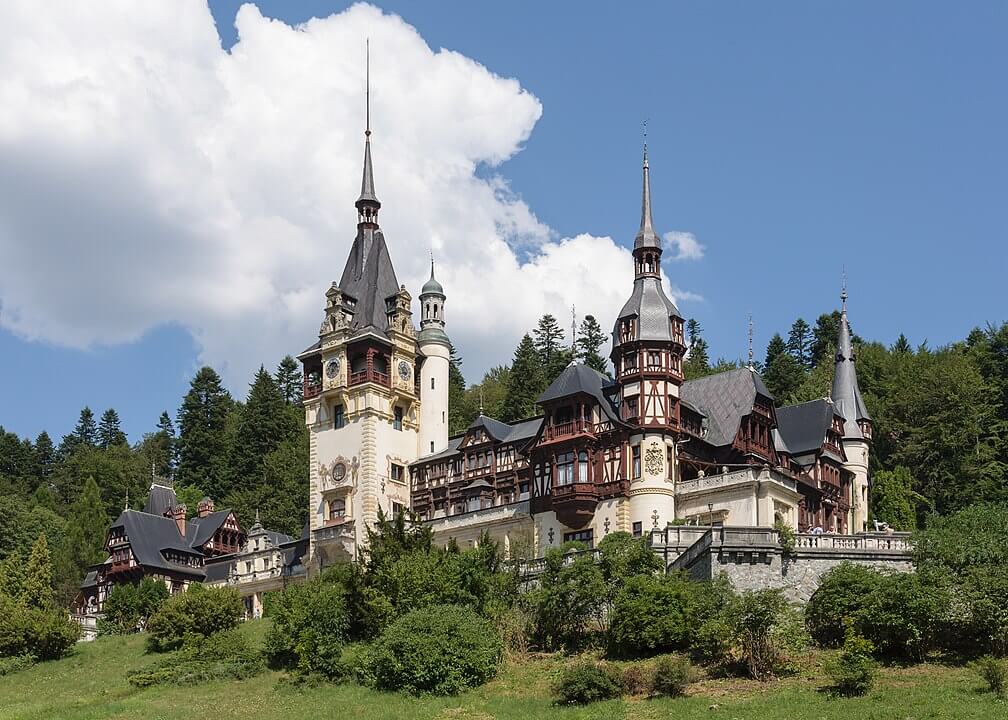
Opatija and Romania
Along the route, you’ll find a vantage point with a gazebo on Queen Elisabeth’s Rock. Locals refer to it as Mala Fortica and walk here to admire breathtaking views. They’re not the only ones. At the invitation of Opatija mayor Ivo Dujmić, Romanian ambassador to Croatia, Mr. Constantin-Mihail Grigorie came here as recently as 2018 to pay his respects.
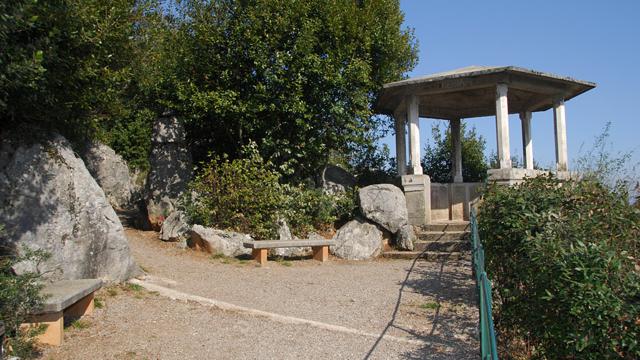
3) Opatija beaches
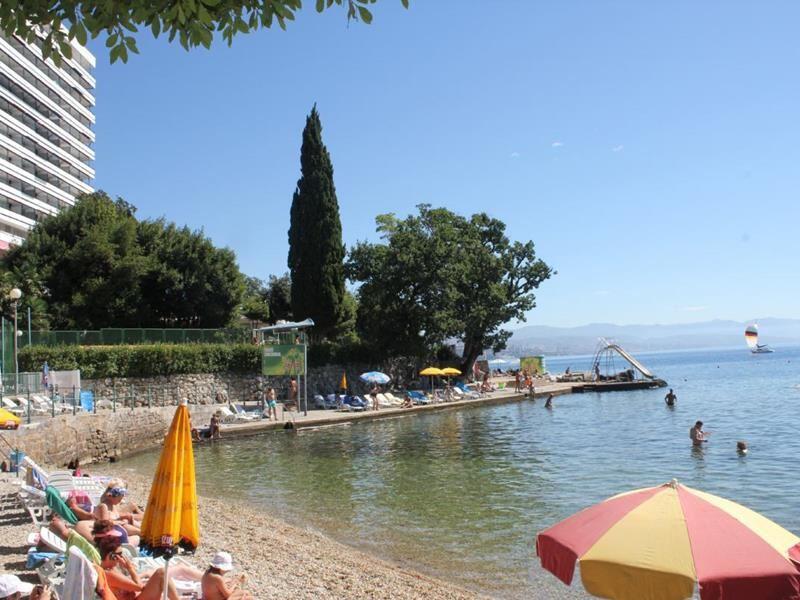
Important to realize that Opatija is not just one town. In fact, it’s a whole riviera. Subsequently, the choices and styles of Opatija beach are great. Even more so if you’re willing to head a little south to Ičići. Or go a little further south by local bus or car.
Family beaches in Opatija
In the heart of Opatija, Slatina beach is practical, accessible and good for the family. Although, Tomaševac beach further north has more to keep them occupied. Specifically, slides, trampolining, pedal boats and a playground. Also to the north, the Lipovica family beach is maybe a quieter option. The kids might need beach shoes here, depending on their age.
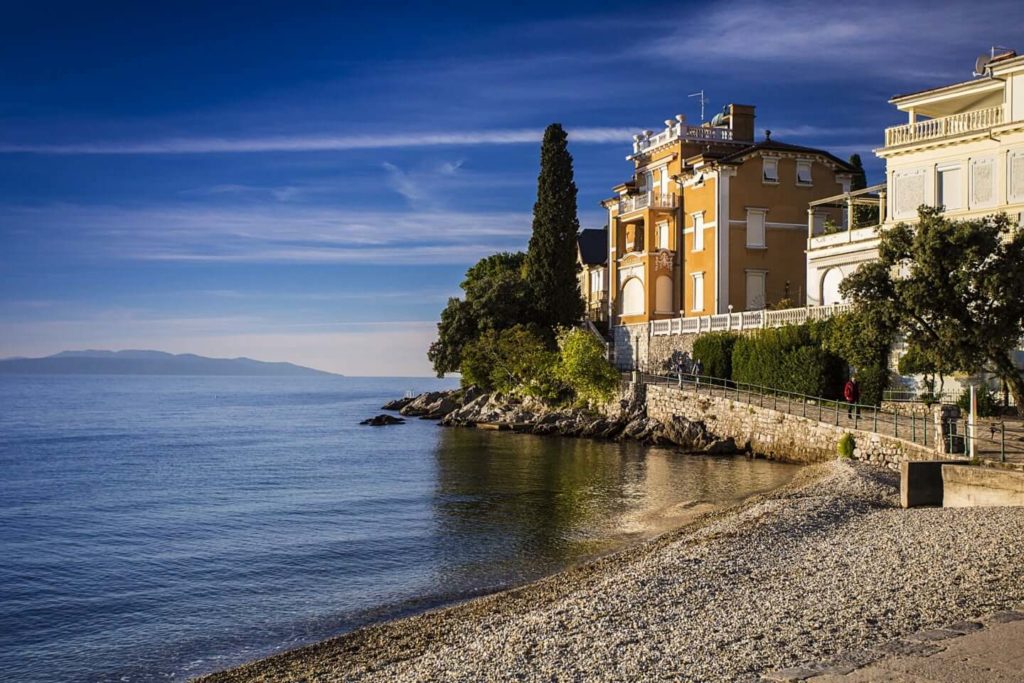
Although it is fully concrete, the tiny Škrbići family beach also has some distractions for the kids. Actually, it’s a lovely little spot, within a tight bay, but close to the centre. Angiolina beach is simply stunning, unique in Croatia. Comprised of an all-wood two-storey block of private beachside huts, it’s an exclusive spot for either well-to-do families, groups or couples.
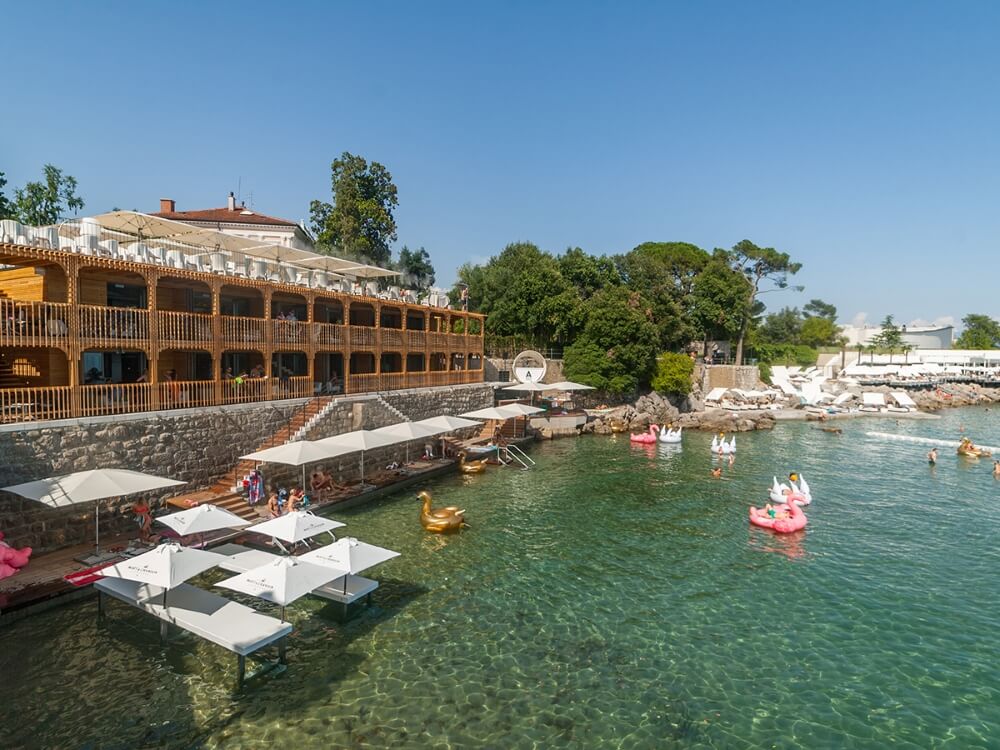
Mature Opatija beach options
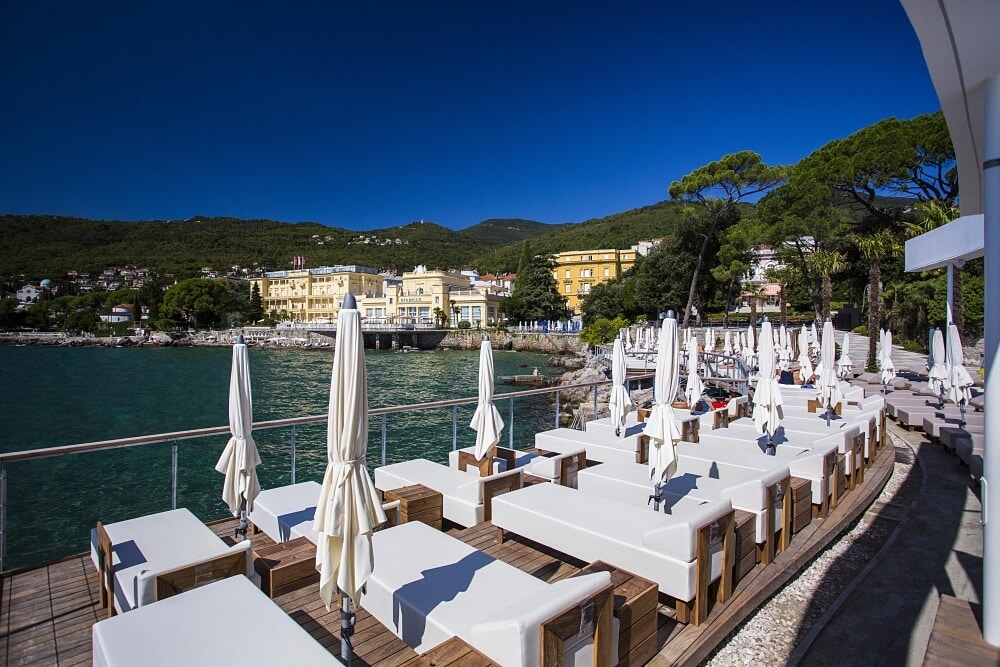
Črnikovica beach in Volosko is an unfussy choice. It’s convenient and therefore popular with locals and young adults. However, if you’re looking for something to fit with your 5-star holiday, there are better places for you. In the centre, next to Angiolina park, Lido beach has swimming pool options as well as the sea. Exclusive sun loungers and waiter service in some spots too. Private beach of the Hotel Royal has more of the same exclusive feel, with sun canopied loungers, but with a kids pool too. Again private, the Hotel Savoy beach has pool, bar and waiter service options, right by the shore.
4) Spa Opatija: Health and wellness
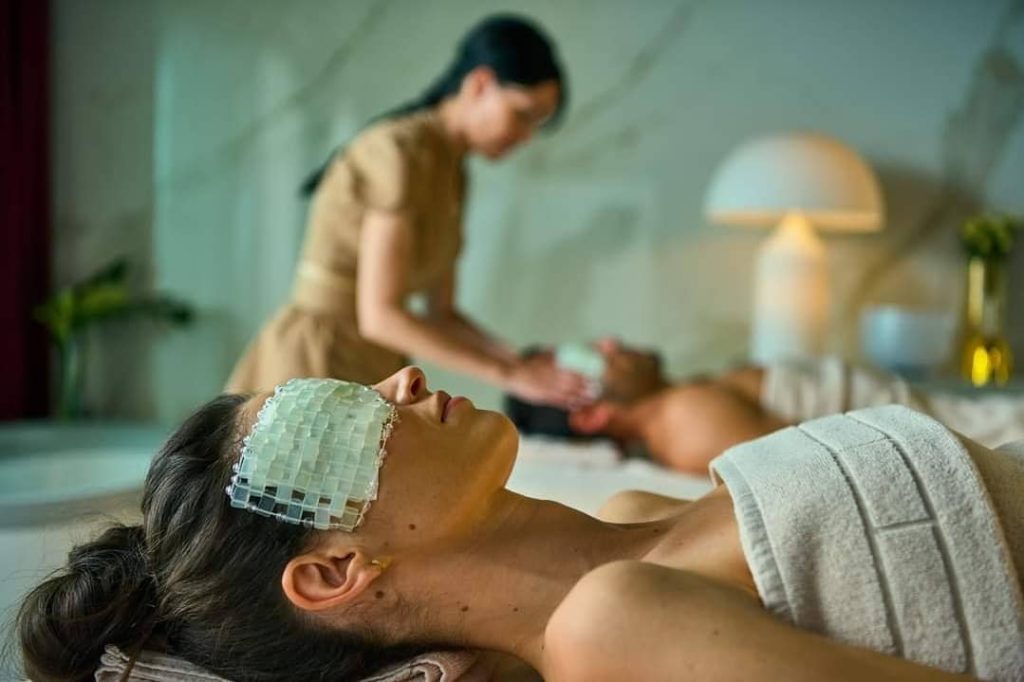
Over 150 years ago, key to Opatija establishing itself as a destination was its natural assets. Although essential, the Adriatic waters, the sea air and mild year-round climate were just the foundations. Before long, a whole supplementary industry of health and wellness grew around them. Opatija became renowned for it. Furthermore, it’s a tradition that continues to expand today.
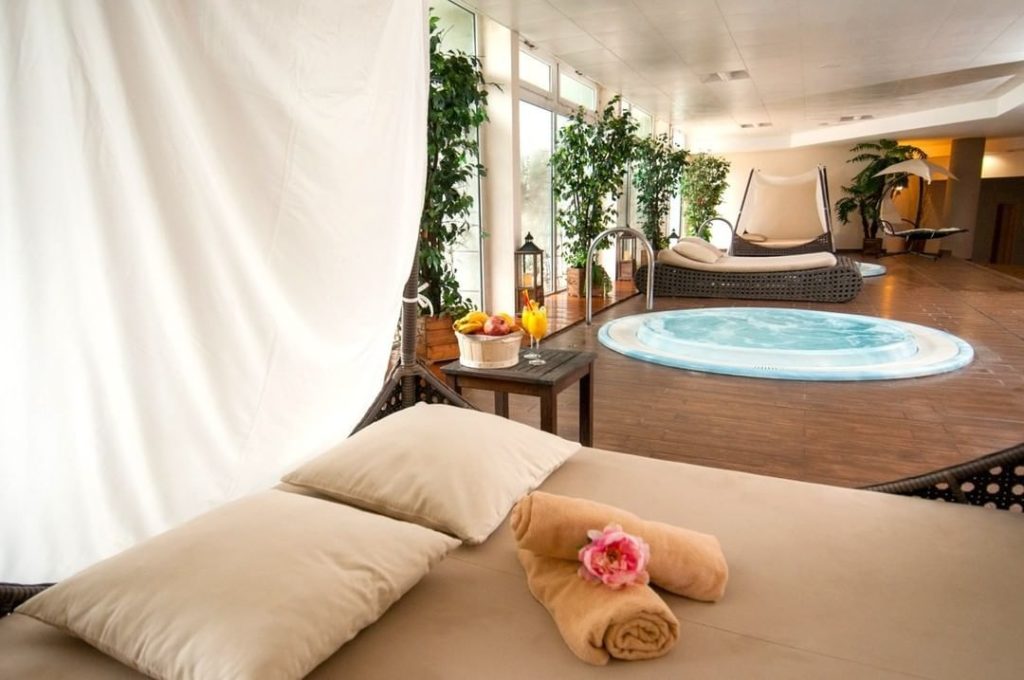
These days, all manner of aromatherapy, facial and body treatments, massages, relaxing baths and sauna sessions are available. Many of the larger hotels offers spa treatments. Indeed, some boutique hotels are specifically built around such offers. If you want to relax, rejuvenate and restore your energy, there really is nowhere better. And, you don’t necessarily need to be a guest of a specific hotel to take up the offer. To see the vast list of what’s available, have a look at the Visit Opatija website (web address at the bottom of this page). You can learn more about Opatija’s 150-year-old reputation as a health and wellness destination later in this article.
5) Marvel at incredible Austro-Hungarian architecture
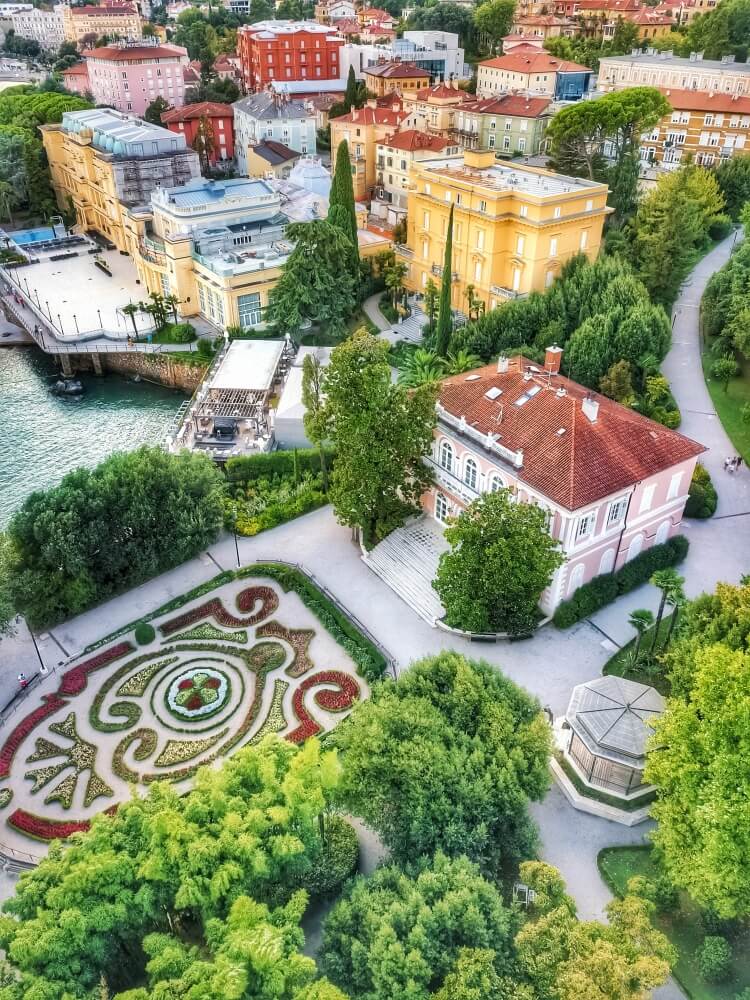
Strolling Opatija’s parks and promenade wouldn’t be half the pleasure without the backdrop of buildings. Grand facades, Romanesque pillars and ornate rooftops peek out from behind the trees. Also, along the town’s main road, hotels you want to stay in next time. Undeniably, this is not Mediterranean, this is something other.
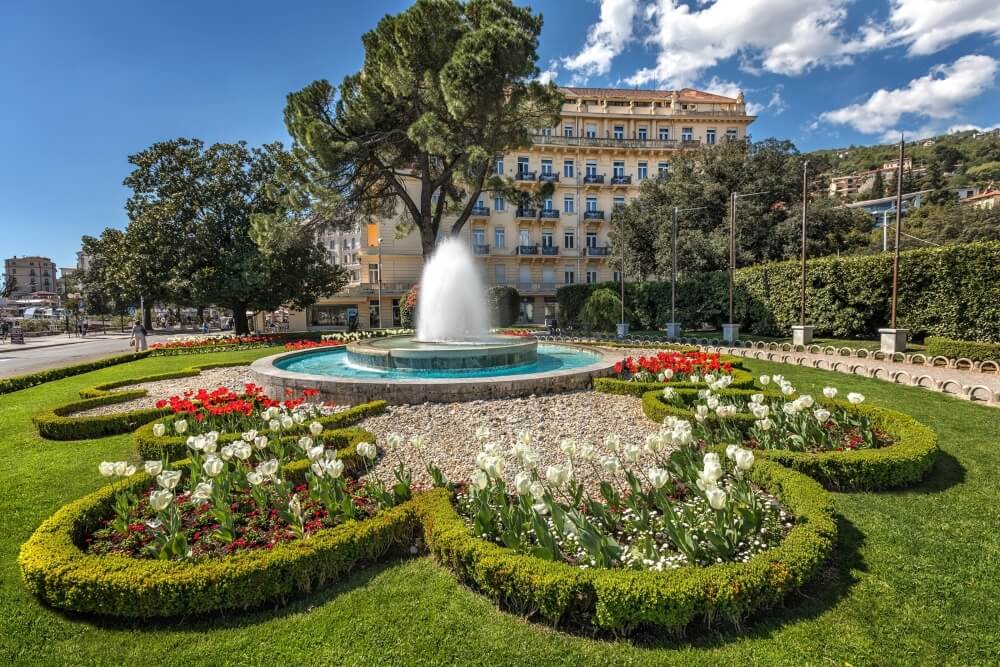
Although these days many come to Croatia looking for the traditional Mediterranean, that wasn’t always the case. Indeed, when the upper echelons of Austro-Hungarian society started coming here, they expected no drop in standard. In other words, they wanted a home from home. With this in mind, Opatija developed an opulent style of architecture. More Vienna than Volosko. Furthermore, it’s a style that has set a precedent. Subsequently, even modern additions impress, deliberately considered to compete with the existing finery.

Carl Seidl
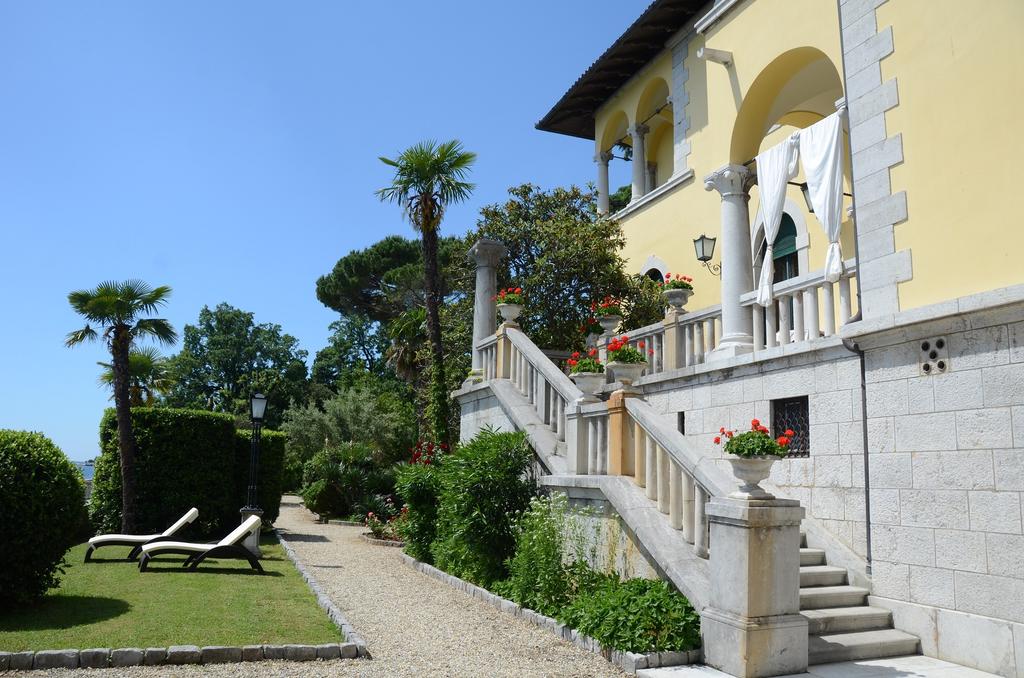
The name of architect Carl Seidl is not one spread across continents. And there’s a very good reason for this. Because his life’s work was more localised. Specifically, the Zürich and Vienna-trained architect dedicated 48 years to creating his opus on the Opatija Riviera. Not only is he here appreciated above all others, but also many believe Opatija’s best buildings to have been gifted by him.
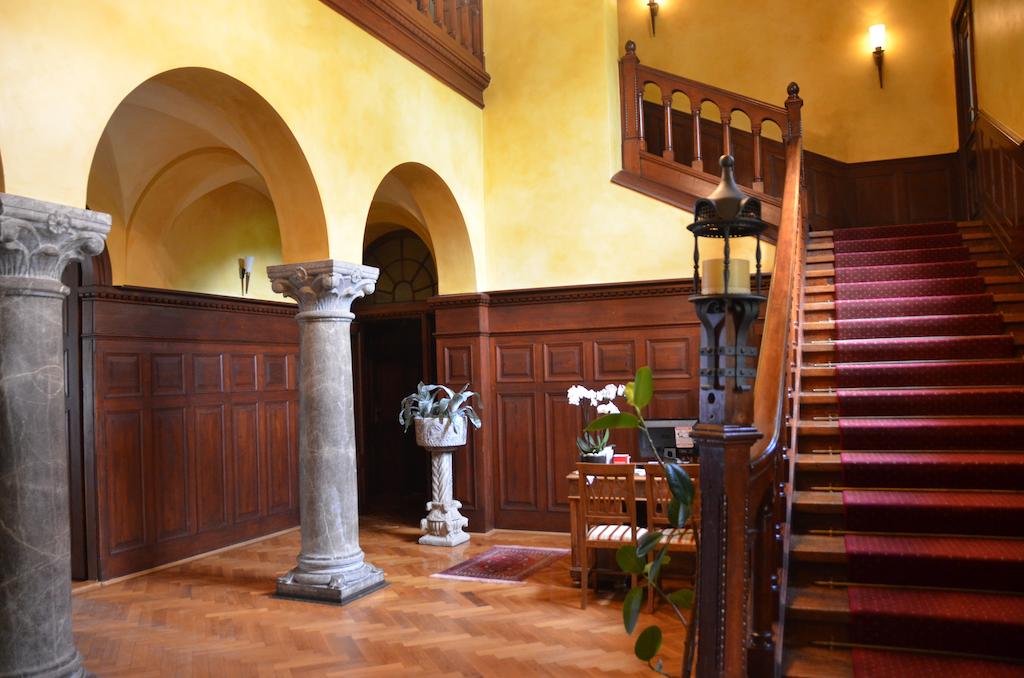
He bequeathed some 31 finished projects to the Opatija Riviera, including 14 villas, hotels, churches, public buildings and baths. Among them, the Brühl (alias Schmidt-Zabierow) and Brunitzky villas, the Evangelist church, court building and town hall in Volosko. So too, the hotels Milenij and Sveti Jakov.
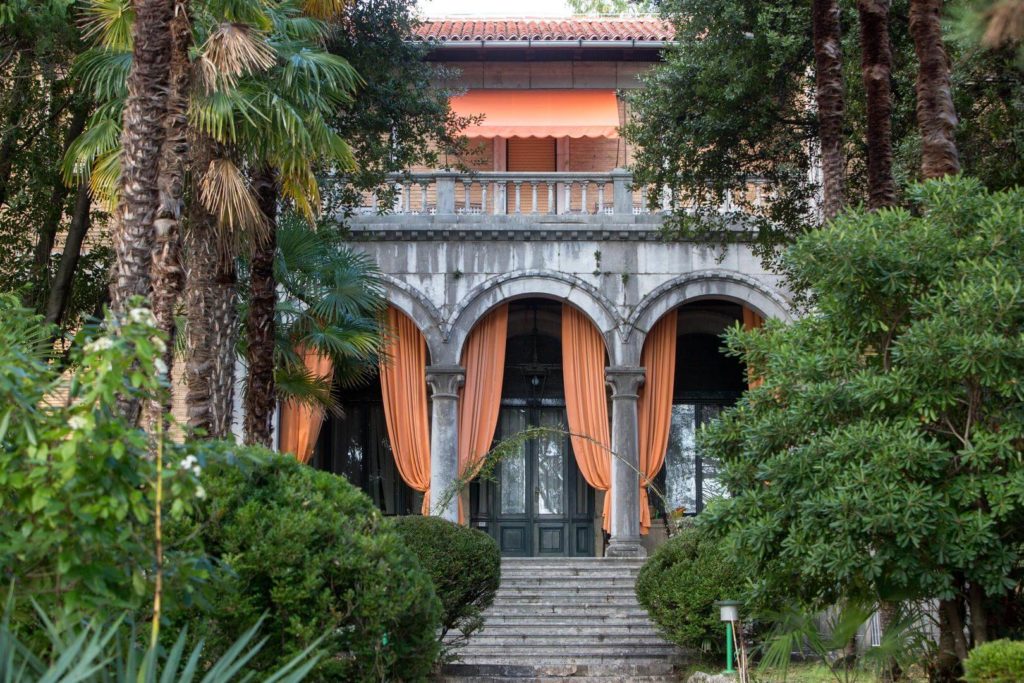
Indeed, some of the villas he designed are simply breathtaking. Markedly, many of the more extravagant personal dwellings are actually in Lovran. As a result of Opatija’s increasing, early popularity, more hotels were built. In order to escape the crowds, some of the more exclusive visitors commissioned their villas in Lovran.
Where to eat in Opatija? Opatija Restaurants
Important to realize that the following does not list every great restaurant in the area. Because there are so many good ones. In fact, almost each of Opatija’s fine hotels has a wonderful restaurant attached. Instead, what follows is a list of tempting suggestions.
North of Opatija
Oštarija Osojnak is set back from the coast in the Pobri/Matulji area. Following a few nights’ fine dining, this relaxed, unfussy grill might be just what you need.
Something rather special
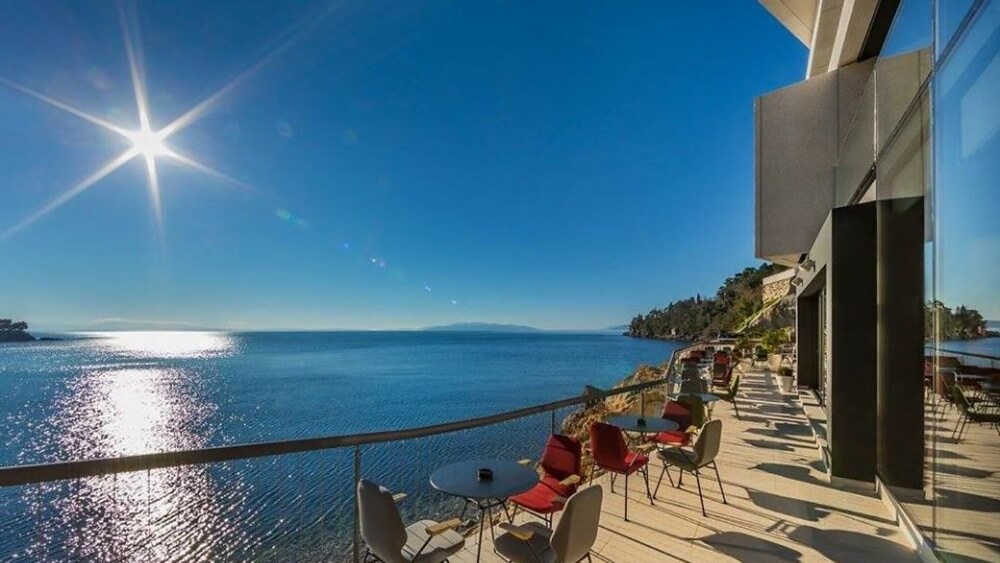
Sailing the islands and want to stop off somewhere special for lunch? Not only does Hotel Navis have its own 40-metre long dock, but also its Michelin-recommended restaurant has great views of Kvarner Bay. Furthermore, alongside the high standard Mediterranean menu, it was the first Kvarner restaurant to specialise in Japanese sushi. Only, you won’t find any imported fish, like salmon, on the menu. Instead, there’s only the freshest regional catch, like sea bass and tuna. Actually, the hotel is way out on its own, halfway between Volosko and Preluk.
Volosko restaurants
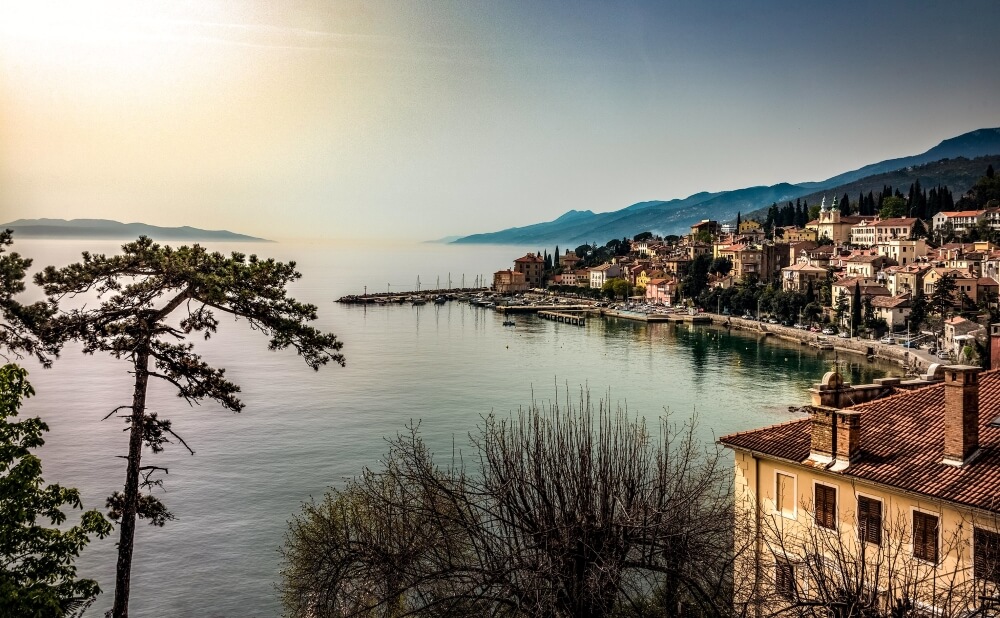
Although the name Valle Losca Tavern conjures up a rustic, traditional place, this is actually well above that mark. While the seating may be informal, the freshness of the seafood and lovely presentation is easily restaurant standard. By the same token, Ostaria Veranda has a relaxed air and placements but, again, the food is very fine. Not only has it got nice views across the bay, but also you’ll sit beneath a natural shade of green leaves.
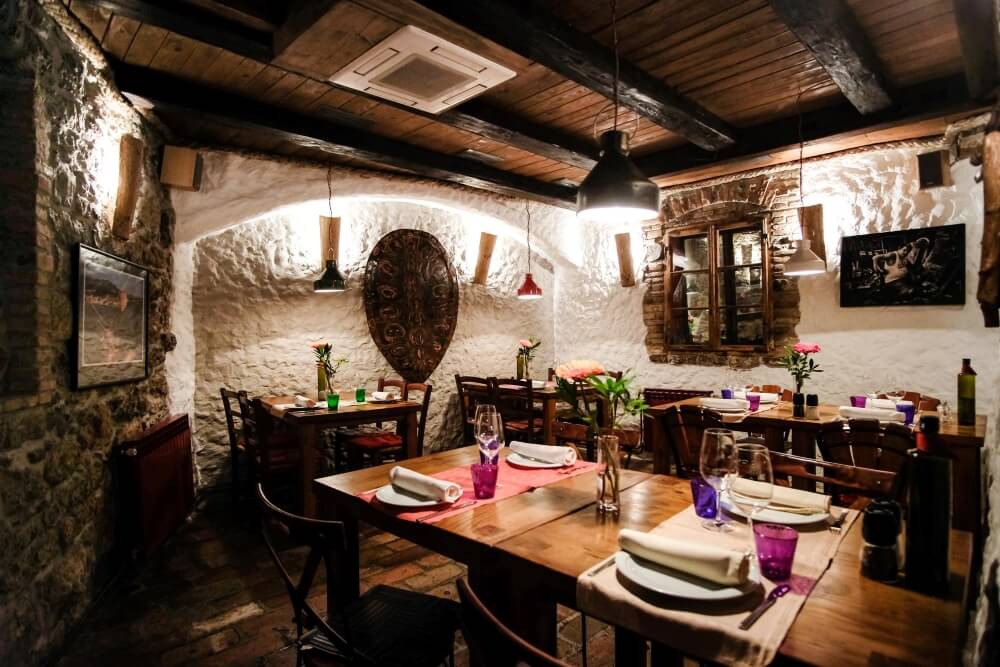
A little hidden back from the port, Konoba Tramerka is a good escape from the forced effort of fine dining. Not only does it have a refreshingly cozy atmosphere, but also it has the traditional seaside menu to match. Actually, one of the best-loved places for fresh seafood is the traditional Tavern Ribarnica Volosko.
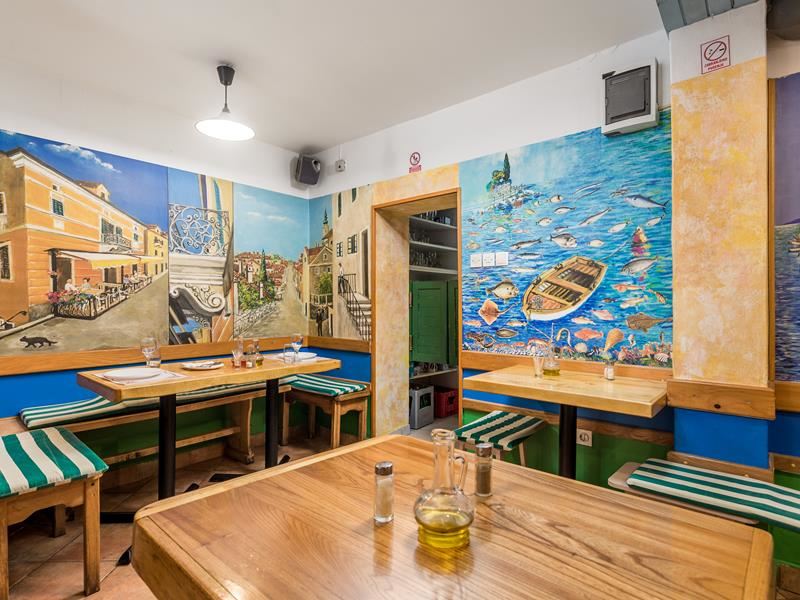
Something rather special
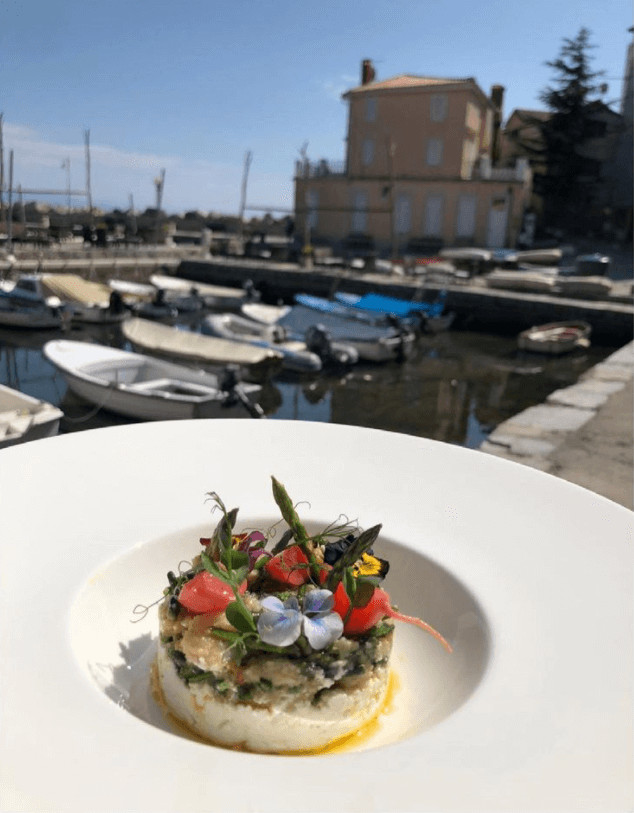
If you are looking for an unfussy, bargain meal that will leave you so full you can’t move, then this is not it. In fact, you’re probably looking for a kebab shop. Although, we’re not sure Opatija has one. But, if you’re after an exquisite fine dining experience, Plavi Podrum is one of the best. Some say it’s the oldest restaurant in the area. Certainly, Volosko’s gastro reputation owes it a lot. If you’re splashing the cash – and, you will be – go for one of the tasting menus. Especially if there are different wines paired with each course. Because this place has a wine cellar full of delight.
Restaurants in Opatija
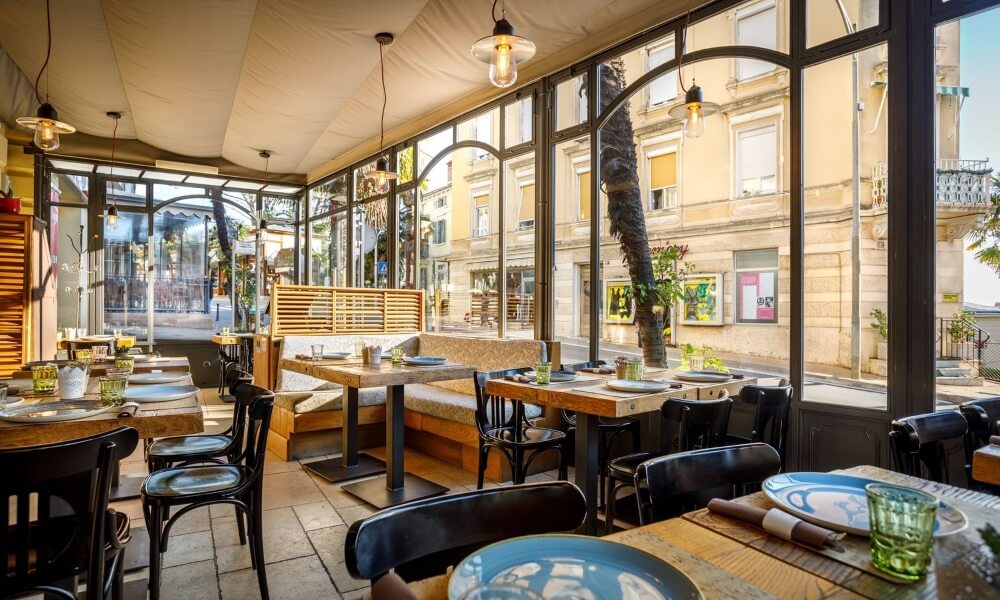
Firstly, no mention of central Opatija restaurants can be made without mentioning Roko. Because it’s become something of an institution. Both big pizzas and pasta dishes, plus sides like potatoes are done properly here. Not only is it a great place for a quality, filling lunch, but also they do special sandwiches to take away.

Of course, this being Opatija, even the barbecue grill restaurants can be extra special. Certainly, that’s the case with Restaurant Ružmarin. If you’re not in the mood for a mixed meat feast, then there are burgers, octopus, pasta or peka. Not only is it all made very well, but also the presentation and informal atmosphere are great
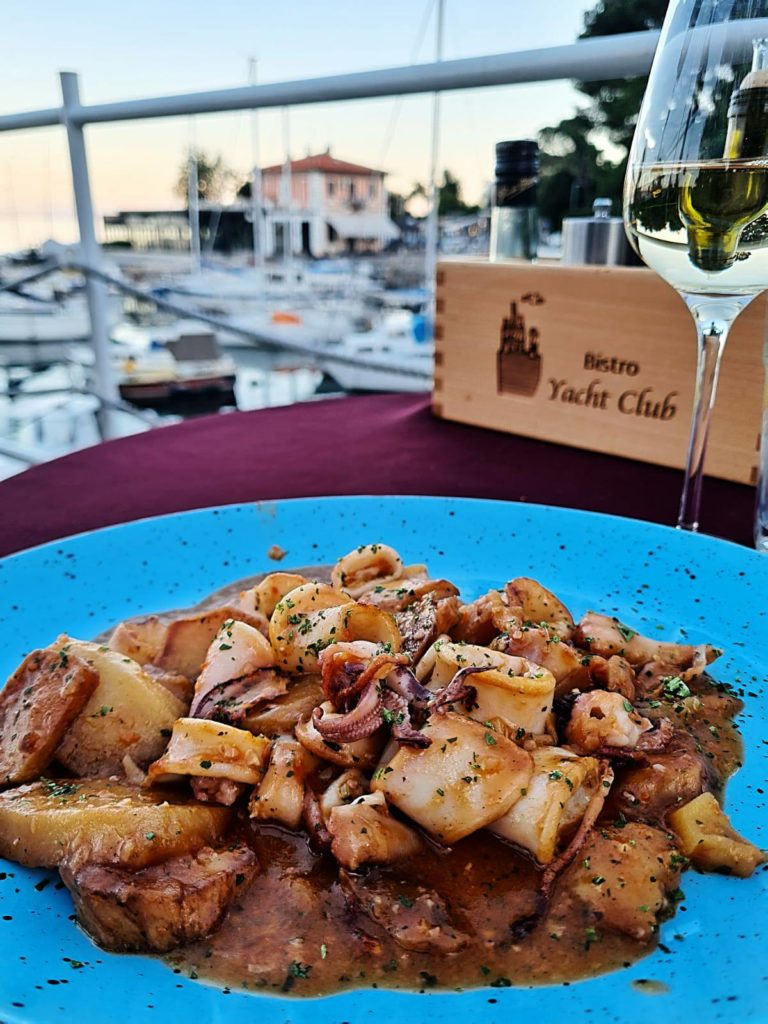
Bistro Yacht Club has a great position, just by the bay. Certainly, it’s the perfect backdrop for enjoying their fresh seafood and well-chosen local wines. They have enough sense to let the main ingredients shine. Although, be aware you may pay a little extra here to eat unstuffy food in such a nice setting. For the most part, what Konoba Istranka does extremely well is classic, rustic Istrian and Kvarner food. Specifically, a mixture of pastas, seafood and meat dishes, served in a kinda chintzy but homely environment. Similarly, holding incredible views, right next to the sea, the design and layout of Bevanda provide an impressive setting.
5 things you (maybe) didn’t know about the town
1) Opatija is the birthplace of tourism in Croatia
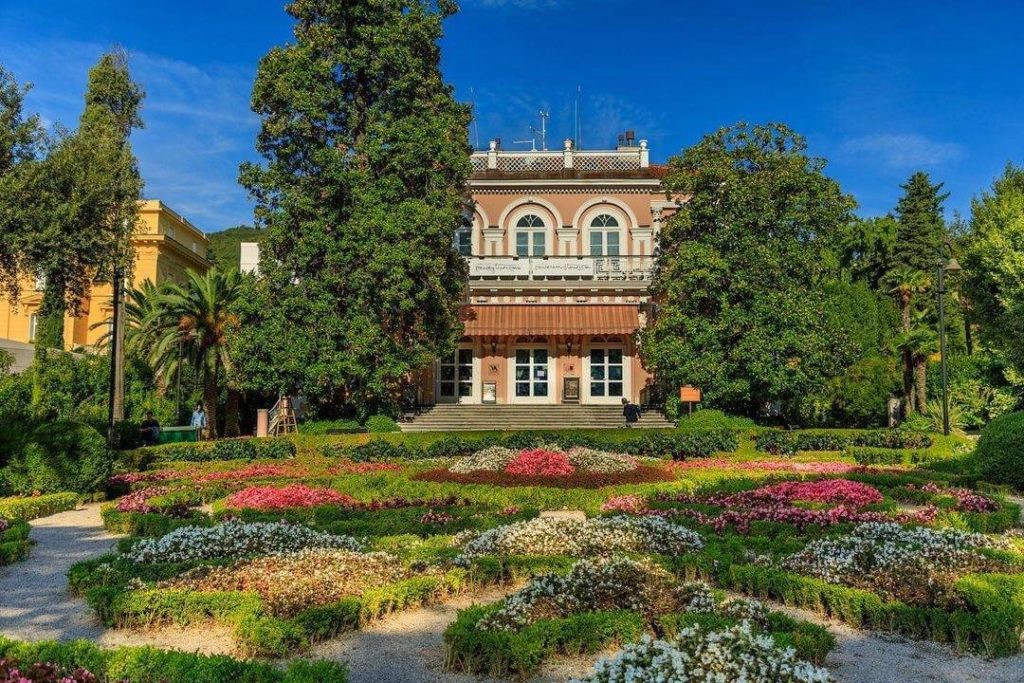
Without a doubt, Croatia owes its reputation as a tourist destination to Opatija. Because it all started here. Not only was Iginio Scarpa a business success in the nearby port of Rijeka, but also his father before him. Subsequently, Iginio decided to put some of the family profits to good use. In 1844, he built the extravagant Villa Angiolina in nearby Opatija as a summer house. No sooner had he finished planting exotic plants in its surrounding gardens, than dignitaries began to visit. Thereafter, the villa became a social hub for upper-class guests, both domestic and foreign.
Especially, it was the foreign visitors who were impressed. In view of the Adriatic from the terrace, a colourful display of unfamiliar vegetation grew in the garden. Certainly, you couldn’t grow such beautiful plants in their cold gardens further north. At the present time, Villa Angiolina houses the Croatian Museum of Tourism.
2) Also, the birthplace of international train travel to Croatia
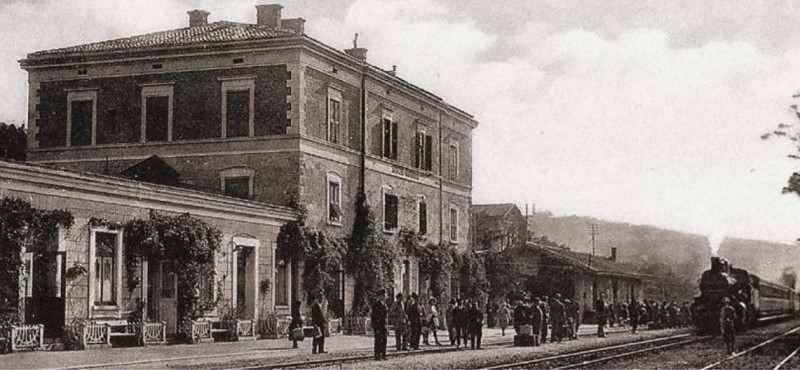
If Villa Angiolina birthed tourism in Opatija, then the railways raised it. Although rail had previously been used internally for industry, the first international passenger line came here. Specifically, in 1873 Vienna’s Southern Austrian Railway company opened the branch line from Pivka (Slovenia) to Rijeka via Matulji.
Explicitly, they did so to facilitate travel to the Kvarner capital city and port. Both businessmen and naval officers required travel to Rijeka. But, it also facilitated visits to Opatija. And, to here, the passengers were less compelled. For them, this was holiday time.
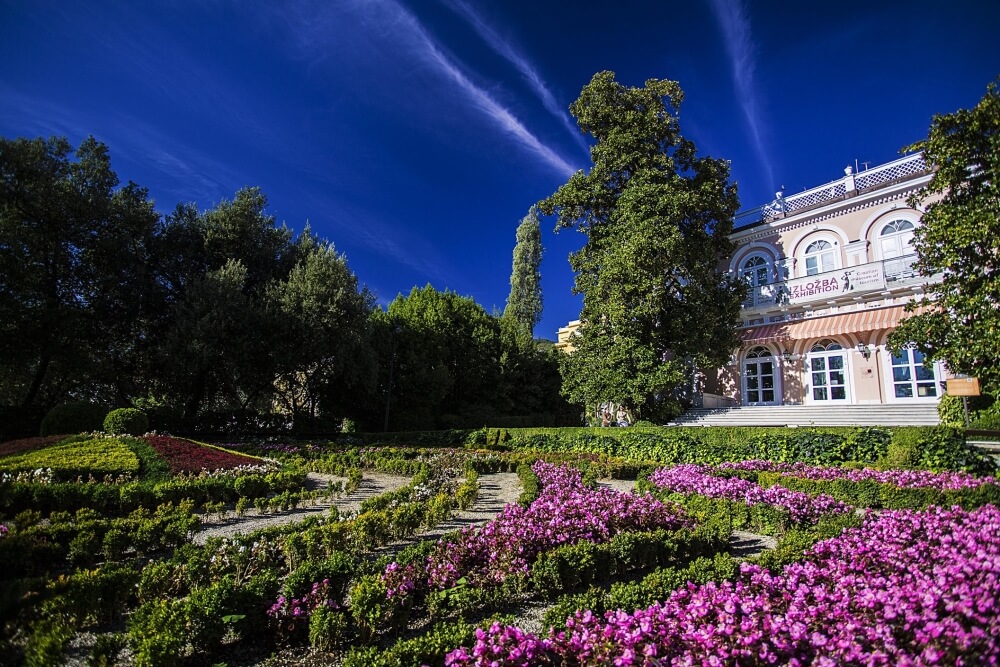
Subsequently, in 1882, the railway company actually purchased Villa Angiolina. Furthermore, Friedrich Julius Schüler, the railways’ managing director, immediately initiated construction of the hotels Quarnero and Kronprinzessin Stephanie. As a matter of fact, both still welcome guests, the former being Hotel Kvarner, the latter Heritage Hotel Imperial. Additionally, the seaside promenade, Lungomare, was built at its behest. So too, Opatija’s public parks.
Eventually, they made one of Croatia’s first electric tram systems. It ran from Matulji to Opatija, then Lovran, between 1908 and 1933. Previously, elite guests had travelled from Matulji to Opatija by horse-drawn carriage. Furthermore, it is said that the large gulf in manners between the rich Austro-Hungarian visitors and the locals who drove the horses was a major reason for the tramway construction!
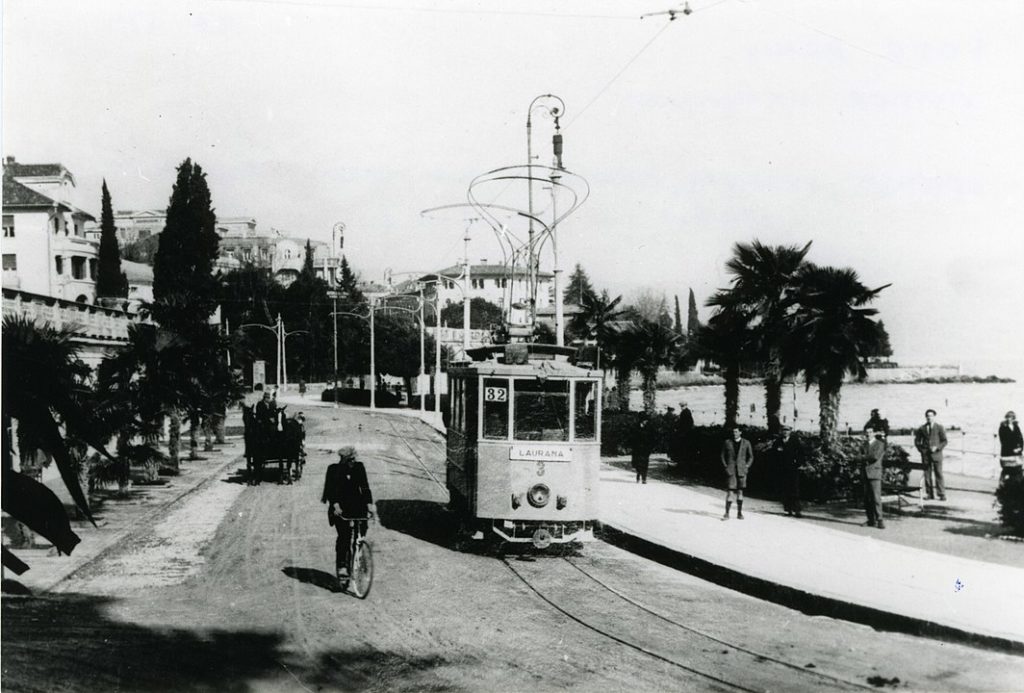
3) Opatija’s famous guests: Austro-Hungarian royalty, the elite of European society and world leaders stayed here
Of course, 150 years ago, extended annual vacations were not for everyone. For the most part, the only people who came to Opatija were society’s elite. Given that, the town has hosted some rather famous names. Indeed, many are depicted in a mural on the open-air theatre in Angiolina Park.
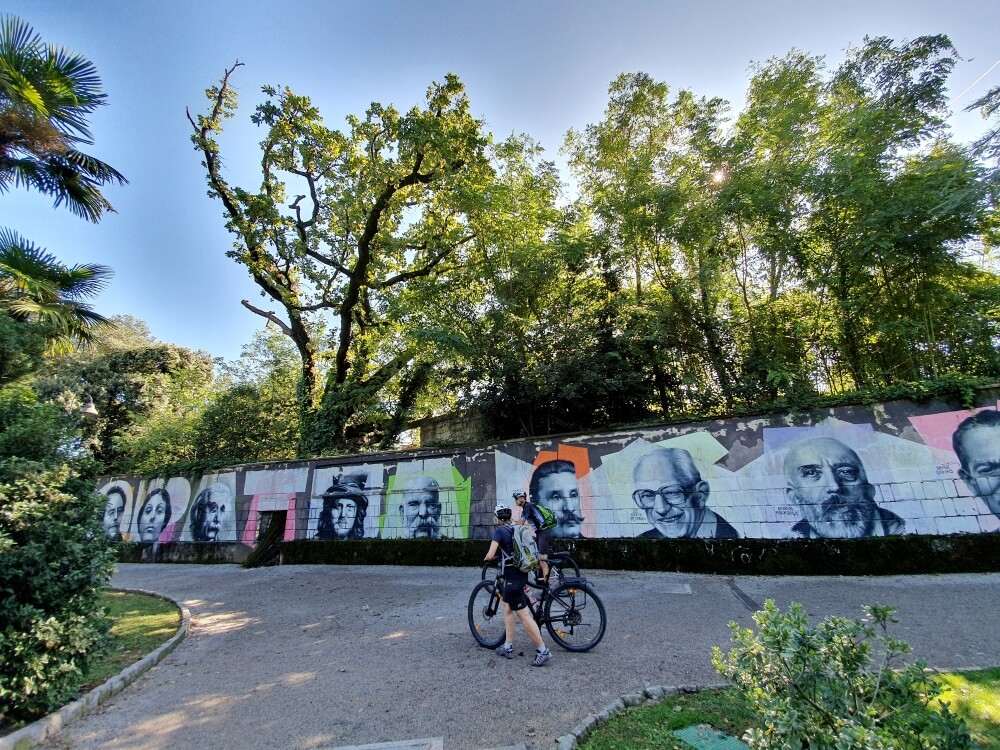
Royalty and world leaders
Among the earliest guests were future Croatian ban Josip Jelačić, German Emperor Wilhelm II Hohenzollern and Empress Maria-Ana. Notwithstanding their rather unhappy union, Rudolf, Crown Prince of Austria and his wife Stéphanie also came. Additionally, Oscar II of Sweden, Ferdinand I of Bulgaria, King George I of Greece, King Albert of Saxony, Grand Duke William IV of Luxembourg, Prince Nikola I Petrović-Njegoš of Montenegro and King Carol I of Romania. Also, Austro-Hungarian Emperor Franz Joseph. Although he was still only Crown Prince when he visited, Aleksandar I Karađorđević of Serbia would eventually become King of Yugoslavia.
Both bourgeois and proletarian leaders came. Specifically, Lenin, Egypt’s Gamal Abdel Nasser, Poland’s Józef Piłsudski, France’s Pierre Waldeck-Rousseau and Josip Broz Tito also visited.
Famous Croatians
Giants of Croatian literature Antun Gustav Matoš and Miroslav Krleža stayed here. So too did Stjepan Radić, a key 20th-century politician outspoken in his advocacy of autonomy for Croatia. Also linked to the town, Andrija Mohorovičić, the founder of modern seismology. Although, you can’t really class him as a visitor. Because he was born in Volosko.
Artists, writers, composers, Nobel Prize winners and more
From the sphere of classical music, composers Gustav Mahler, Franz Lehár, Pietro Mascagni and Giacomo Puccini were repeating visitors. So too, Rafael Kubelík and his father Jan Kubelík. Famous writers included Russian heavyweights Anton Chekhov, Sergei Yesenin and Vladimir Nabokov. Also, giant of Irish literature James Joyce and Hungarian playwright Ferenc Molnár.
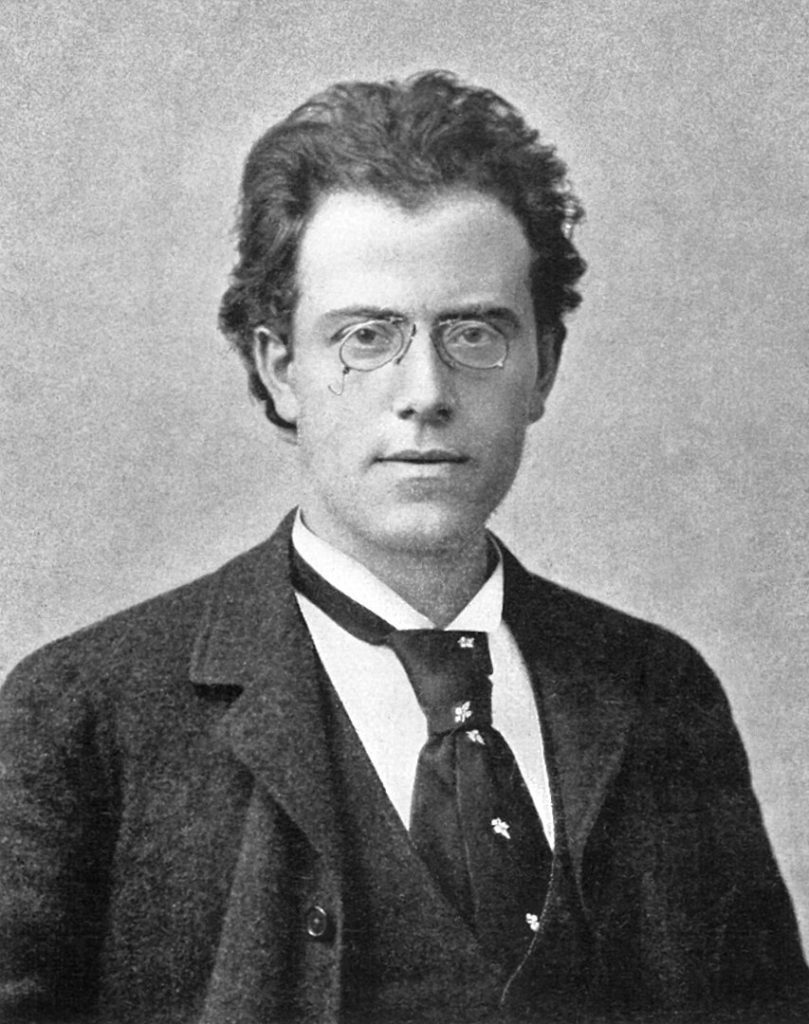
Albert Einstein’s visit is so cherished it is remembered by a wall plaque. Internationally acclaimed dancer Isadora Duncan was said to have been inspired in her work by the palms in Opatija. Also inspired by the town, artist Giorgio De Chirico. Motion picture pioneers the Lumière brothers were here. More contemporary names from the movie world include stars Kirk Douglas and Robert De Niro.
Additionally, at least 6 Nobel Prize winners visited. In detail, Emil von Behring and writers Bertha von Suttner and Henryk Sienkiewicz. Also, Otto Loewi and writer Salvatore Quasimodo. Lastly, Travnik-born writer Ivo Andrić.
4) The birthplace of health, wellness and medical tourism in Croatia
Certainly, the mild year-round climate was one of Opatija’s best assets for early visitors. Indeed, the extended summers and sea air earned a reputation as restorative. Therefore, many who came would prolong their stay to reap the benefits to health. In order to facilitate this aspect of visits, several spa and treatment facilities were established.
Again, it was Opatija infrastructure pioneer and town champion Friedrich Julius Schüler who laid the foundations. Not only did he instigate the construction of Lungomare, but also he invited renowned spa physician Julius Glax and other authorities on health here.
Opatija: a spa town and centre of treatment and medical excellence
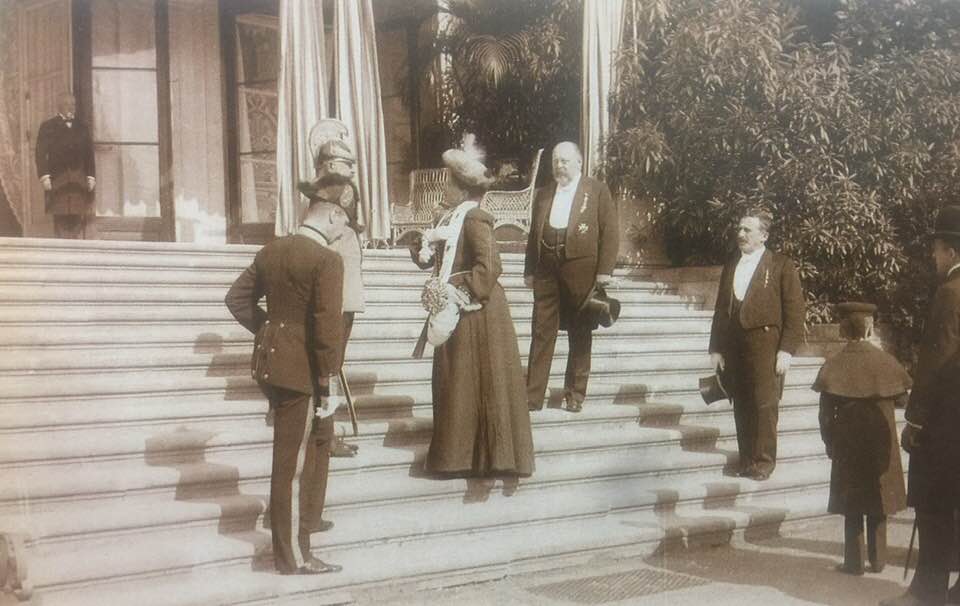
Indeed, with Glax persuaded to move here in 1883, the town’s repute grew. Not only did he treat very famous guests, but also others travelled specifically to visit him. Eventually, he became head of the town’s Health Resort Commission. Also, he organised world congresses on thalassotherapy here. He was joined in the town by renowned surgeon Theodor Billroth, who spent his later years living in Opatija. Additionally, Dr. Leopold Schrötter von Kristelli, an expert in laryngology, who established the healing properties of aerosols in Opatija. Also, Dr. Rudolf Virchow, the founder of cellular pathology. Subsequently, Nobel Prize-winning physicians Emil von Behring and Otto Loewi became returning visitors.
After its reputation for thalassotherapy (seawater treatment) was established, Opatija eventually became a world leader. Indeed, in 1954, the renowned Čedomil Plavšić was invited to come. Subsequently, he founded Opatija’s Thalassotherapia institute. Furthermore, his pioneering methods drew international experts to medical conferences in the town.
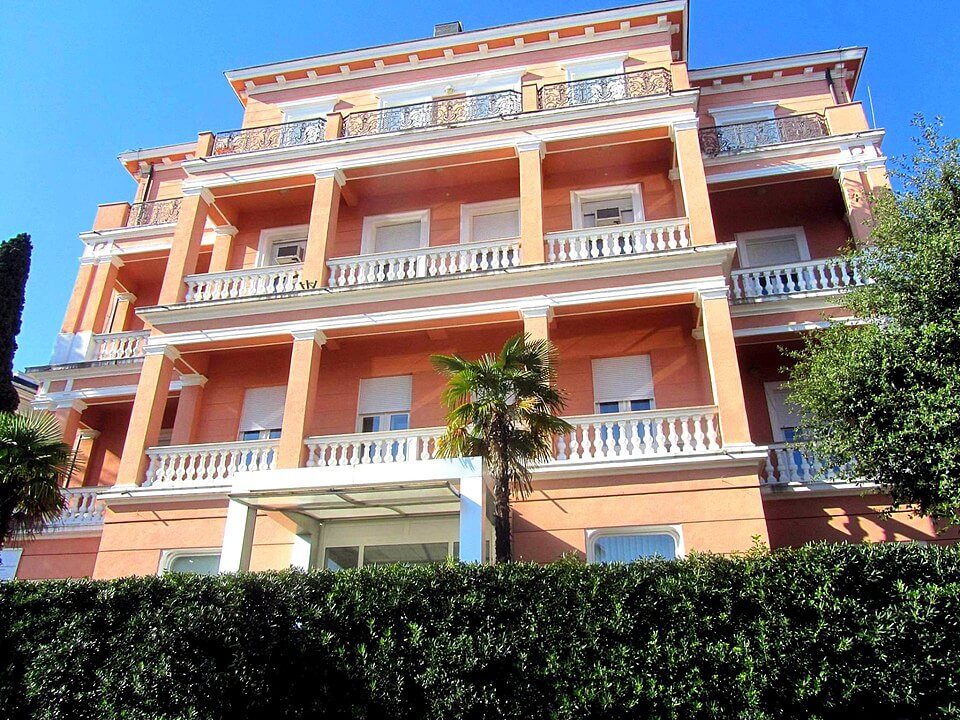
A lasting legacy of health and wellness
The tradition of health and wellness continues in Opatija today. Specifically, several hotels offer different spa and therapy treatments. But, the industry has nowadays expanded to include medical procedures. Furthermore, it has outgrown Opatija and spread to the wider Kvarner region.
5) One of the most romantic places in Croatia
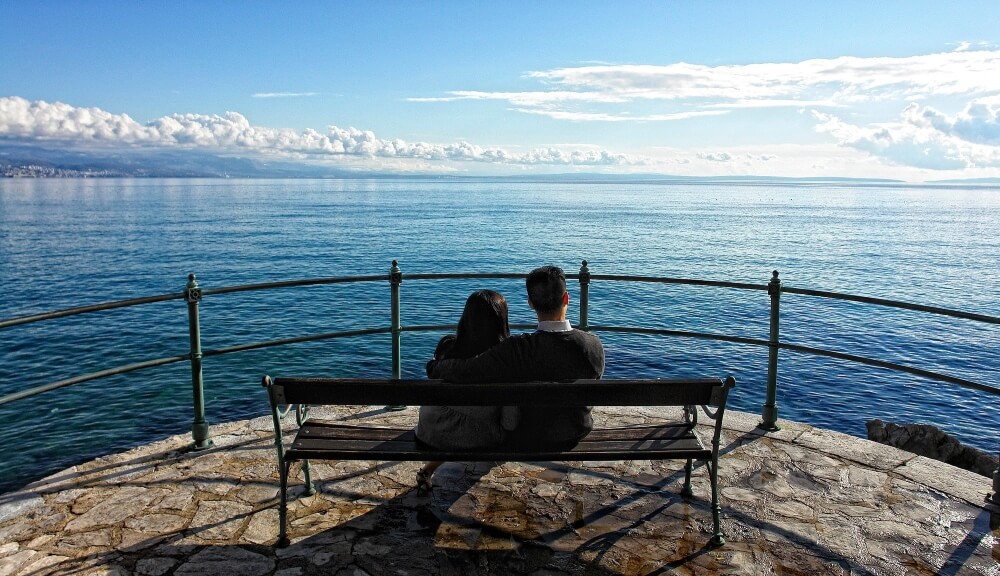
Both families and solo travellers are warmly welcomed in Opatija. Indeed, there are a whole range of activities aimed at families. However, accommodating all does not detract from Opatija’s reputation for romance.
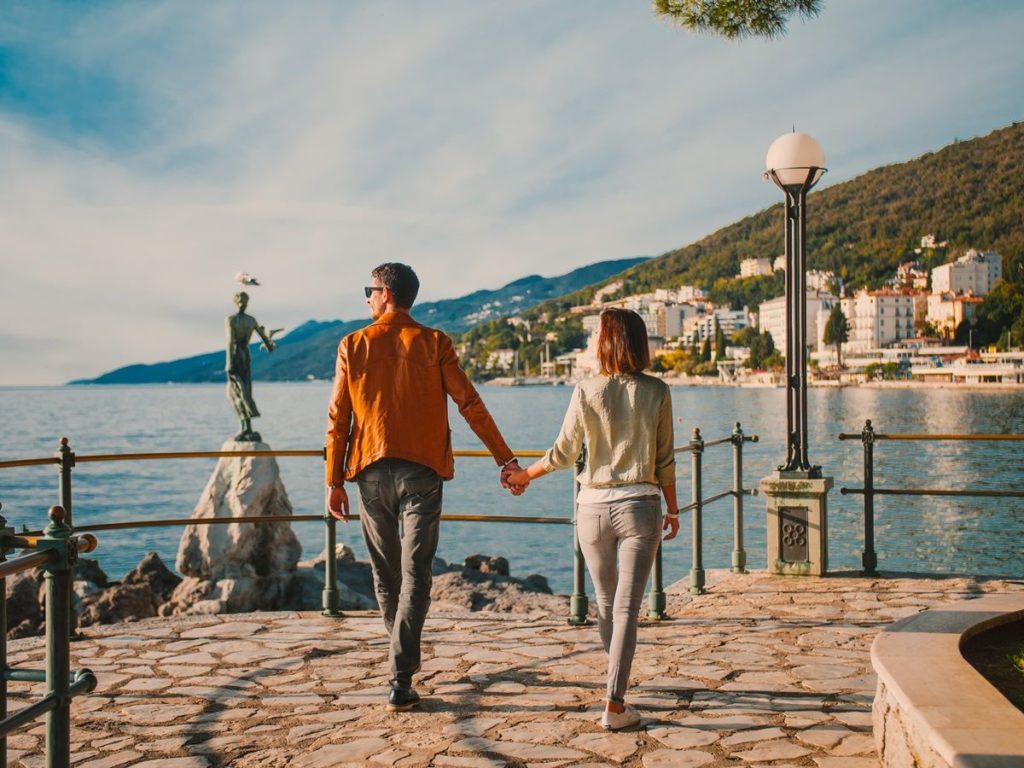
Whether intentional or not, Opatija actually looks like it was built just for two. For example, take Lungomare, the seaside promenade. Certainly, it’s perfect for a hand-holding couple. So too, the perfect parks, best enjoyed at an unhurried pace. Not to mention the ornate buildings and dinners for two by the shore. If sunrise across a beautiful shimmering bay is your perfect way to greet the day, then this is the place for you.
Where to stay in Opatija? Opatija hotels, real estate, property
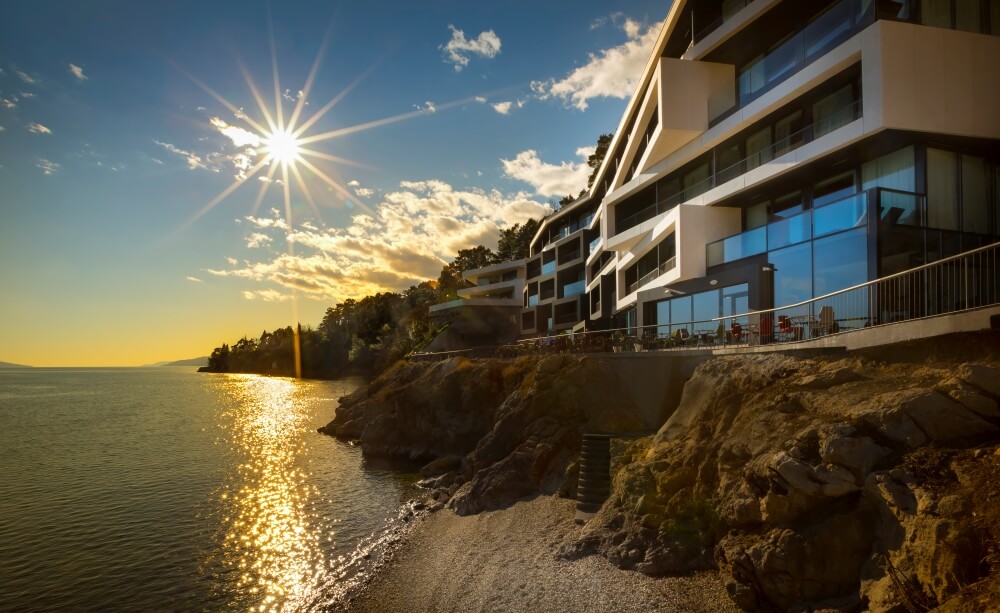
Hotels in Opatija
Overall, the standard of accommodation in Opatija is extremely high. Certainly, a destination with a 100-year-old reputation for tourism, you’d expect as much. But, the sheer range of options now available is staggering compared to what it once was.
If you’re looking for 5-star modern hotel rooms, you can get that at Hotel Navis. Additionally, the Ikador, Mozart, Hotel Bevanda, Hotel Sveti Jakov, Hotel Milenij and Hotel Ambassador are top of the range. Although, these are nearer the centre. Not only are there many more 4-star and 3-star options, but there are also smaller boutique hotels. Furthermore, many of the latter have special themes or are especially appropriate for couples. Altogether, it simply depends on what kind of visit you want to make. Both romantic couples and families, not to mention solo travellers and groups, can find a place here.
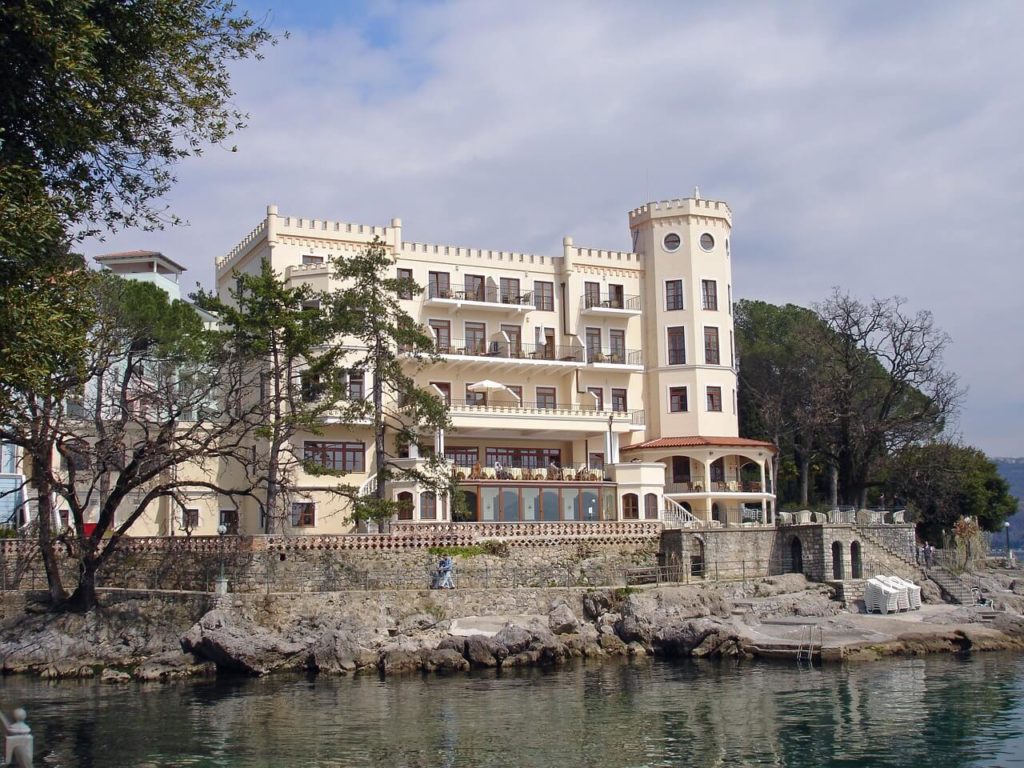
Villa Opatija vacation rental, apartment Opatija, camping in Opatija
Without a doubt, villas in Opatija and apartments in Opatija come in every style, size and price range. If you’re looking for a secluded Opatija holiday home with a pool for the family, then there are many options. Similarly, if you just want to rent a room in Opatija centre, you can do. Certainly you should check out the usual booking platforms to see the options.
Alternatively, if you’re looking for camping Opatija, you might have to head a little further south. Although there is one campsite in Opatija itself, also you’ll find nice options in Medveja and Mošćenička Draga.
Opatija real estate, Opatija property to buy, buy a house, holiday homes, buy land
Fallen in love with Opatija? We don’t blame you. In fact, many people think to retire in Opatija or buy a holiday home in Opatija. But, if that love extends to you wanting to buy a house in Opatija, where to look? Opatija Nekretnine at Maršala Tita 88/1 have houses, apartments and land from across the riviera. Furthermore, they are experienced at working with international customers. Ivera by the Barisic family specializes in property in this specific region. Moreover, they’ve been doing it for two decades. Also, they are on Maršala Tita 100.
Additionally, Smart – invest immobilien at Maršala Tita 75/1 and, a little further south at Maršala Tita 162/3, Premium nekretnine both have high-end, luxury properties. In detail, these are all very close to one another. So, take a walk around and check out each portfolio. However, buying a house in Opatija is a recognised desire. Subsequently, you’ll doubtless find properties and plots on the books of national estate agents and estate agents in Zagreb and Rijeka.
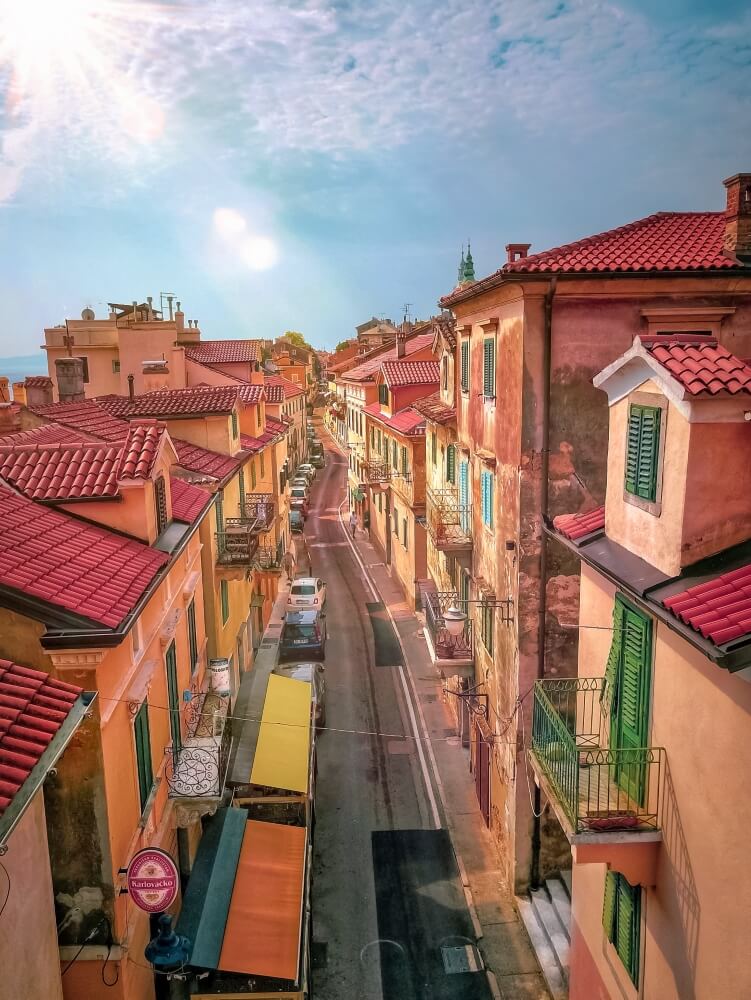
Where is Opatija Croatia? Opatija map and location
Opatija is located in the northwest of Croatia, on the northeastern tip of the peninsula Istria. It is a coastal town. In detail, its GPS coordinates with respect to latitude and longitude are 45.3376° N, 14.3052° E. And the Opatija zip code is 51410 Opatija Croatia (postal code).
Opatija weather: Today and next 7 day weather forecast
Weather in Opatija is mild and pleasant throughout the year. In detail, the summers are long and warm, but rarely too hot or too dry. Also, the winters are never too cold. Wondering about the weather in Opatija in May? Pondering the Opatija weather in October? Doubtless, Opatija out of peak season is a peaceful and pleasant time to visit. Actually, Opatija’s mild, pleasant climate is the reason the town became internationally renowned. Here’s how the weather in Opatija looks today and the Opatija weather forecast for the next few days.
| Mon | Wed | Thu | Fri | Sat | Sun |
| +12° | +11° | +11° | +13° | +12° | +11° |
| +11° | +4° | +4° | +5° | +5° | +8° |
var css_file=document.createElement(“link”); var widgetUrl = location.href; css_file.setAttribute(“rel”,”stylesheet”); css_file.setAttribute(“type”,”text/css”); css_file.setAttribute(“href”,’https://s.bookcdn.com/css/w/booked-wzs-widget-275.css?v=0.0.1′); document.getElementsByTagName(“head”)[0].appendChild(css_file); function setWidgetData_24757(data) { if(typeof(data) != ‘undefined’ && data.results.length > 0) { for(var i = 0; i < data.results.length; ++i) { var objMainBlock = document.getElementById('m-booked-weather-bl250-24757'); if(objMainBlock !== null) { var copyBlock = document.getElementById('m-bookew-weather-copy-'+data.results[i].widget_type); objMainBlock.innerHTML = data.results[i].html_code; if(copyBlock !== null) objMainBlock.appendChild(copyBlock); } } } else { alert('data=undefined||data.results is empty'); } } var widgetSrc = "https://widgets.booked.net/weather/info?action=get_weather_info;ver=7;cityID=19175;type=3;scode=124;ltid=3458;domid=w209;anc_id=37558;countday=undefined;cmetric=1;wlangID=1;color=137AE9;wwidth=160;header_color=ffffff;text_color=333333;link_color=08488D;border_form=1;footer_color=ffffff;footer_text_color=333333;transparent=0;v=0.0.1";widgetSrc += ';ref=' + widgetUrl;widgetSrc += ';rand_id=24757';widgetSrc += ';wstrackId=343132';var weatherBookedScript = document.createElement("script"); weatherBookedScript.setAttribute("type", "text/javascript"); weatherBookedScript.src = widgetSrc; document.body.appendChild(weatherBookedScript)
Best day trips to make
Rijeka
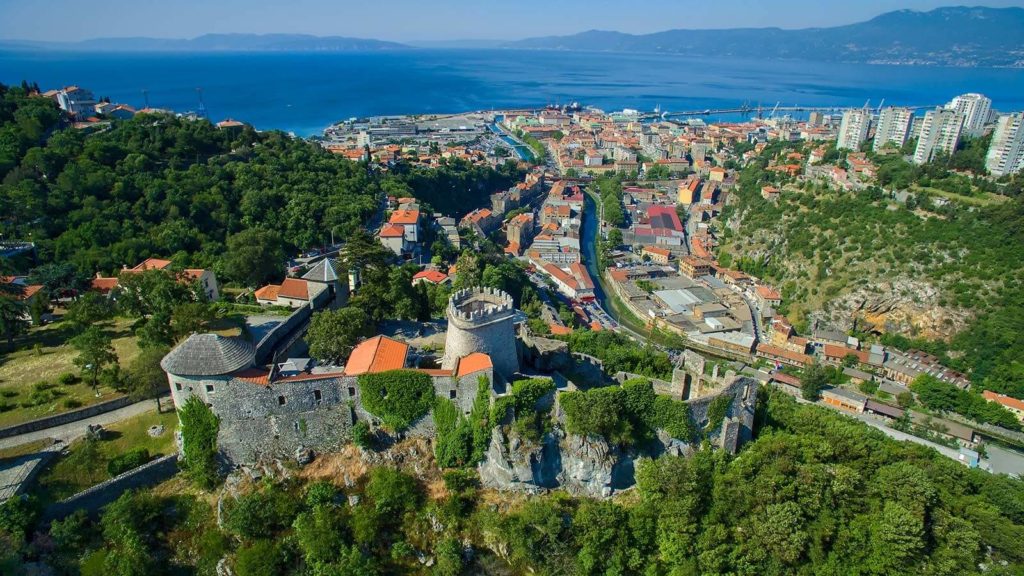
If you’re looking for a greater variety of shopping, museums and a more youthful, modern city, then head here. Both a university town and a major port, Rijeka has many cultural and entertainment distractions. Furthermore, it’s only 25 minutes by bus or car. Subsequently, it’s perfectly placed for dipping into from Opatija. In fact, it’s so close, you don’t even need to make a day of it. Find out all about Rijeka in our detailed guide.
Pula
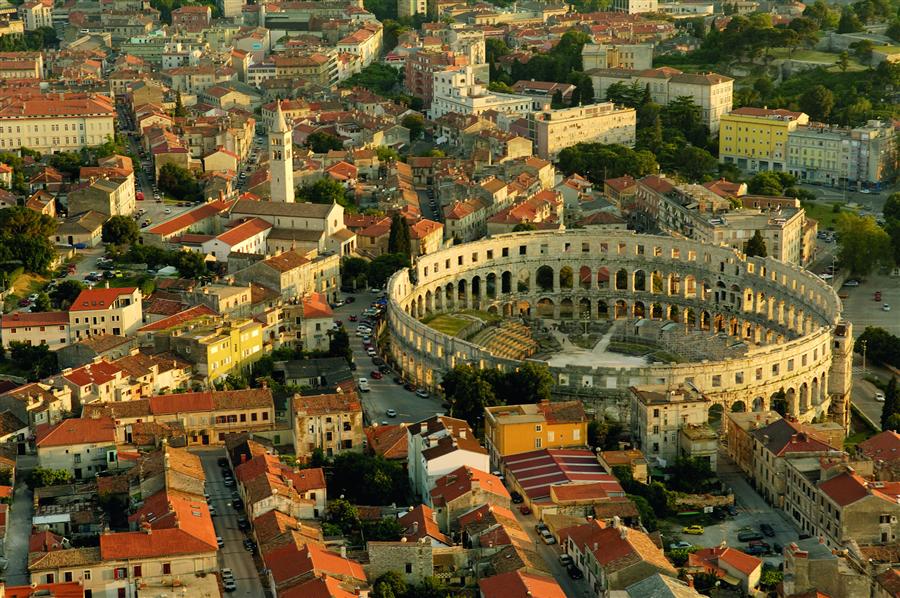
Capital city of Istria, Pula’s Roman heritage is second to none. In fact, Pula Arena is the best-preserved Roman amphitheater outside Italy and a national emblem. But, there’s so much more besides. Not only is Pula brimming with brilliant history, but also it is vibrant, modern and forward-thinking. You can find out more about the city in our detailed guide.
Venice
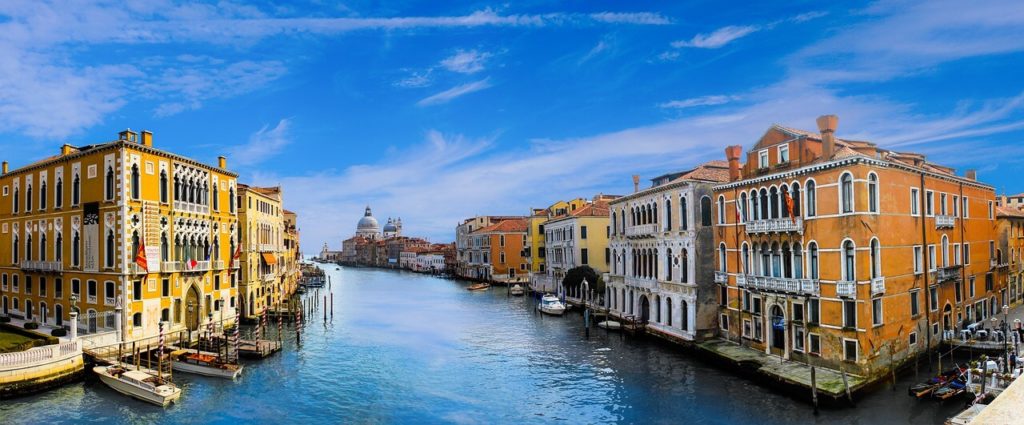
Travel options for a day trip from Opatija to Venice include car, private transfer, bus via Trieste or train. By train, go from Opatija Matulji station to Pivka in Slovenia (2 hours), change there for Trieste (1 hour 20), where you change again for Venice (2 hours). There are only one or two trains a day between Opatija Matulji station to Pivka, so if you’re going to do this, plan carefully. You can also travel from Opatija to Venice by boat or ferry, via Pula. To learn more how to take a ferry or catamaran to Venice, look here.
Učka Nature Park
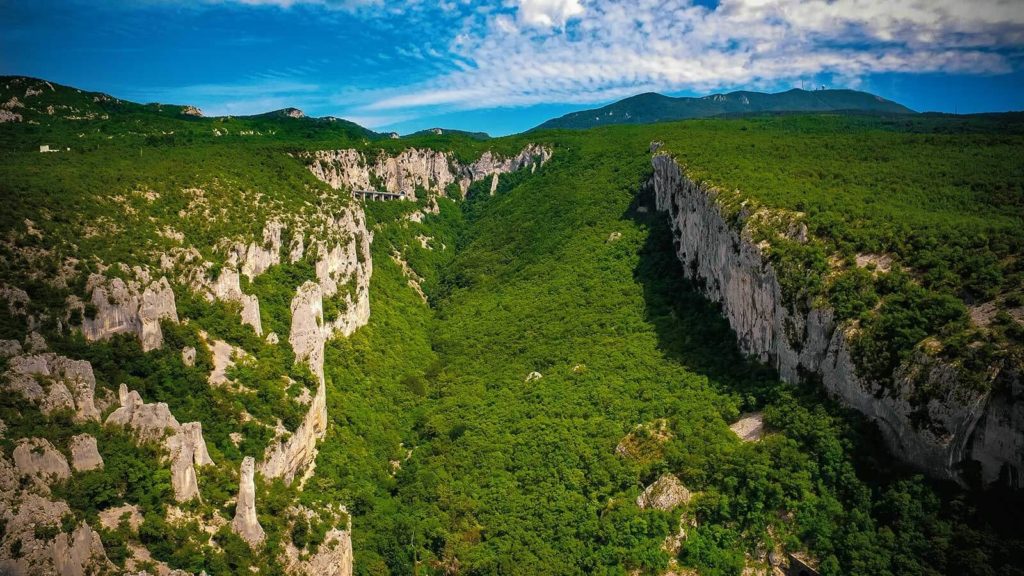
The whole area surrounding Učka mountain is protected. However, more often than not, it the high peak of the mountain in Učka Nature Park that visitors most come to see. The view it gifts is epic, a spectacular vista of mountains, beach, forest and sea. Actually, you can take your car near to the top. Specifically, you’re advised to park at Poklon at 922m. However, for active types, the park is great year-round for walking and hiking.
Significantly, Opatija holds a particularly inviting trail for hikers. If you want a challenge, then check out the Opatija Mountain Tour (Opatijska planinarska obilaznica). In detail, the circular route connects 10 peaks above Opatija. Moreover, it is 45 km long and can be covered in 15 hours and 30 minutes. Certainly, if you want to walk it all, plan carefully in advance. Specifically, check out the route on the Opatija Mountaineering Association website. Additionally, you can contact them or Opatija Tourist Board.
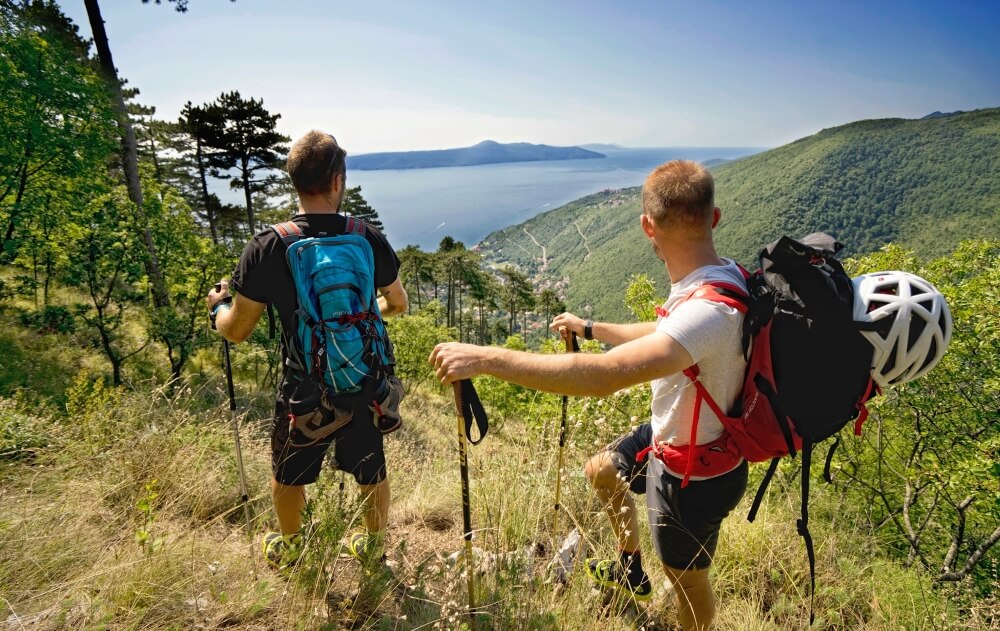
How to get to Opatija and get around
Flights to Opatija, Opatija nearest airport

Opatija is serviced by two international airports. The nearest airport to Opatija is Rijeka airport. Specifically, the distance from Rijeka airport to Opatija is less than 40 km. In detail, it takes around 35 minutes to travel from Opatija to Rijeka airport by car. Furthermore, travelling from Rijeka airport to Opatija by bus is extremely easy. You can here read everything you need to know about flights to Rijeka and the airport itself.
The next nearest airport to Opatija is Pula airport. The distance from Opatija to Pula airport is around 80 km. To get from Pula airport to Opatija by car, follow the road directions immediately below. Furthermore, it’s super easy to get from Pula airport to Opatija by bus. Specifically, just hop on a local bus from Pula airport to Pula. Thereafter, take almost any intercity bus heading for Rijeka. Because they all stop in Opatija. You can here read everything you need to know about flights to Pula and the airport itself. Actually, Zagreb (200 km), Trieste (107 km) and Ljubljana (135 km) airports are all quite close. Also, Venice airport is 3 hours drive away.
Road, by car
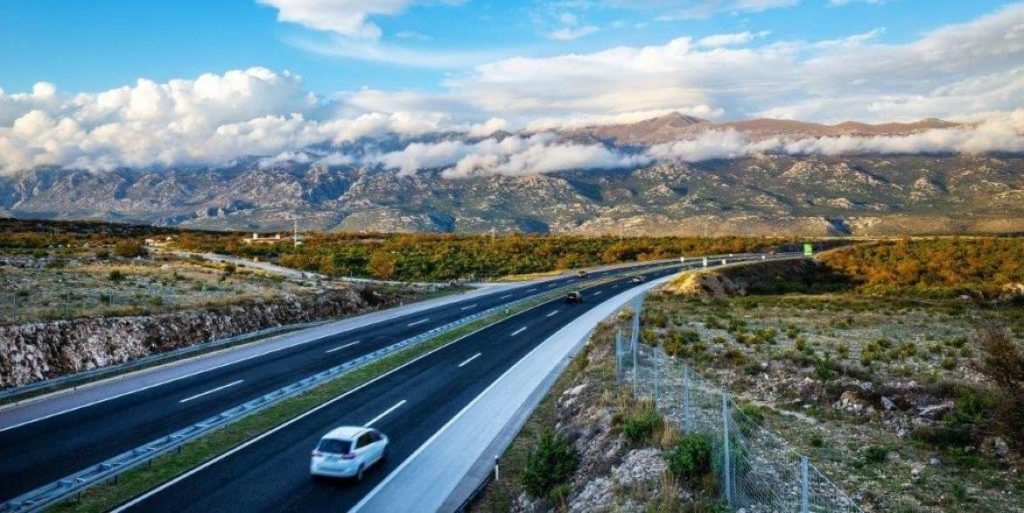
Opatija is located just off the Croatian A7 motorway, which runs from Rijeka to the Slovenian border. To get from Zagreb to Opatija, take the A1 motorway to Rijeka. Then, at Trsat, take the A7 til Matulji, where you leave the motorway network and drop down to Opatija. If you’re travelling from Dalmatia, then again, head north on the motorway until Trsat. Thereafter, follow the same directions.
If you want to get from somewhere in Istria to Opatija by car, it depends where in Istria you are. If you’re setting off from anywhere on the east of the peninsula, then just follow the coastal roads north until you get on the D66. Similarly, you can take the scenic D66 all the way if you want to get from Pula to Opatija by car. However, from Pula and anywhere on the west side of the Istrian peninsula, there’s a quicker option. Specifically, you join the Istrian ‘Y’ motorway network, which runs through the interior.
Looking for a fast, reliable and trouble-free transfer to or from Opatija? Contact TC transfer partner Adriatic Transfers for your one-stop solution.
Rent a car Opatija
If you want to rent a car in Opatija, then the best advice is to book it in advance. If you’re staying at a hotel in Opatija, then ask them about car rental when you book. Not only do some offer it themselves, but also they might arrange for your car to be waiting at the airport or train station when you arrive. Certainly, all of the larger hotels will work regularly with a car rental company they recommend. If you’re staying in private accommodation and must arrange things yourself, then you have several options. Try Uni Rent car rental at Ulica Viktora cara Emina 2 in the centre.
Boat rental Opatija
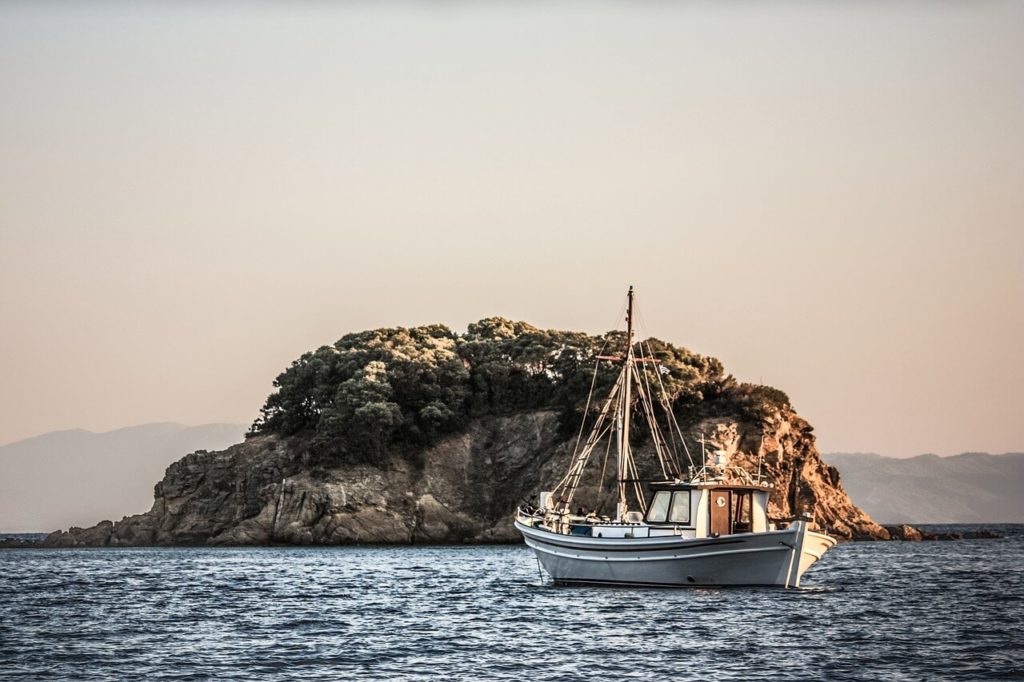
Certainly, with the epic Kvarner bay stretching out before you, it’d be a shame not to get close up. Not only will renting a boat in Opatija open up the coast, but also a whole range of activities. If you want to hire a boat with a skipper to take you from Opatija to Cres island by boat, then try Marea at Poljanska cesta 1, Ičići. Not only do their half or full-day tours take in the island or coast, but they’ll also drop you off somewhere recommended for lunch. Afterward, they’ll pick you up.
Also, Ema & Marlin Boat tours between Ičići and Lovran do a range of tours. Notably, they are the sole outfit to organize full-day swimming trips for groups (up to 12 people). Also, it’s the only one that offers Light Tackle Bottom Fishing. And, if you ask in advance, they’ll make a barbecue on the boat.
Whether you’re looking to hire a small boat for a family, with or without skipper, or if you need to accommodate a much larger party, talk with Quarnero Tours. Not only do they do half-day excursions, but also full-day tours and boat rentals. Paragvaj Tours offer a boat with a skipper for families or a small group, with snacks included in the trip. By comparison, Contessa Tours can accommodate a much larger party. If you’d prefer to go fishing by boat, then speak to Robert at Big Game Fishing. Not only will he take you far out to where the tuna can be found, you might also see some dolphins.
Plan ahead for hiring a boat in Opatija
Because hiring a boat can be quite the investment, do ask for recommendations and advice. Not only should you read online reviews before you book, but also you should ask at your hotel or Opatija Tourist Board Information Centre for recommendations. You can find the latter at Ulica Maršala Tita 128 in Opatija.
Train to Opatija
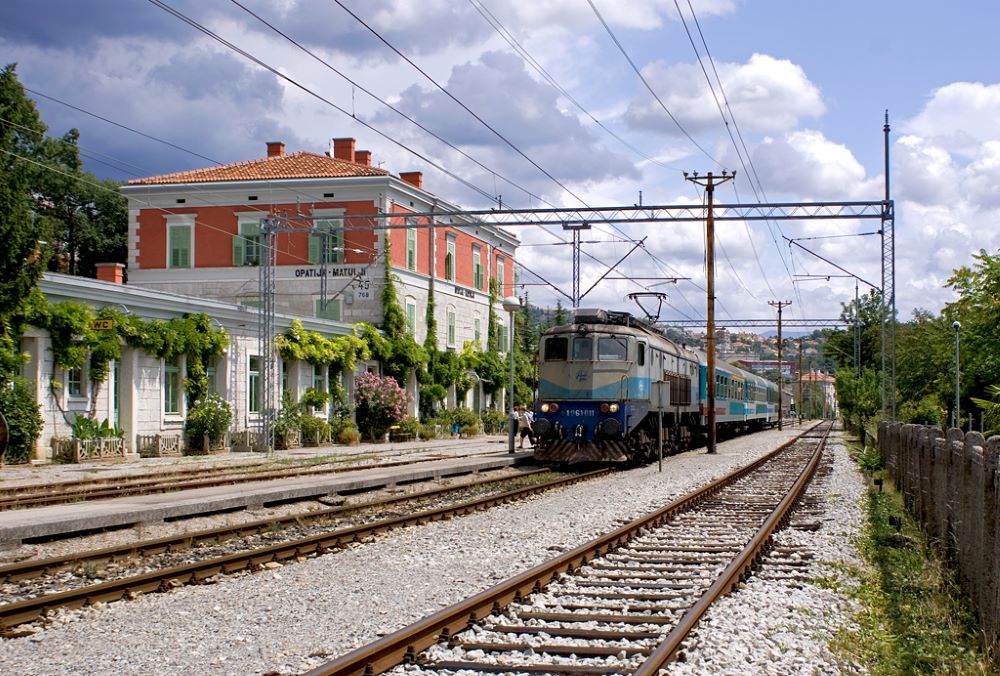
Opatija is serviced by the Opatija Matulji train station. In fact, the train is a 100-year-old choice for visitors to reach Opatija. However, the train station is not within walking distance of Opatija. Therefore, you’ll have to make provisions for the journey. Take a taxi from Opatija Matulji train station to Opatija. But, make sure you get a quote in advance. In detail, it should cost around 10 Euros. Alternatively, you can get from Opatija Matulji train station to Opatija by local bus.
Opatija is connected to many international cities via train, including Venice. Specifically, most intercontinental trains pass through nearby rail transport hub Rijeka. You can find out how to get to Opatija by train from international destinations via Rijeka here.
Bus: local and intercity
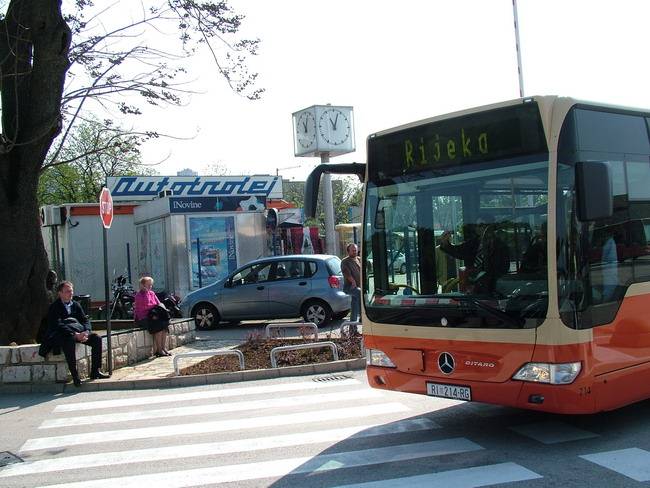
Travelling intercity by bus in Croatia is a fast, popular and reliable option. Indeed, you can easily reach Opatija by bus from anywhere in Croatia. Furthermore, you’re on a busy intercity bus route in Opatija. Not only do almost all buses between continental Croatia and Pula via Zagreb and Rijeka stop here, but also all buses between Dalmatia and Pula. Learn more about travelling through the country by bus here.
Furthermore, Opatija is connected to nearby Rijeka by local bus operator Autotrolej. Find out more about Autotrolej lines, timetables, ticket offers and buy tickets from their great website here.
More information
Not only does Opatija have a helpful Tourist Board who you can contact online at visitopatija.com, but also a Tourist Information Centre. You can just drop by, anytime. In detail, you can find it at Ulica Maršala Tita 128 in Opatija. Both German language and English language visitors are accommodated here. Also, of course, Croatian and Italian-speaking guests.
To follow the latest news from Opatija, check out Total Croatia News.

